How About More Sheep Photos?
/Photos of sheep and the story of why this group is named after nuts.
Read MoreJuly, 2023: I have switched to writing most of my blog posts on my original WordPress blog so access all the current news there and sign up on that site for email updates.
Photos of sheep and the story of why this group is named after nuts.
Read MoreI always like to get photos of all the sheep before shearing. I can go back and compare before and after shearing photos (which I find interesting) and I can find photos of some of the favorites as they have grown up. Yesterday I spent a ridiculous amount of time editing the sheep pages on the website to reflect which sheep are in the flock now. That included making sure I had photos of all the sheep—and I do have updated photos of almost all of them. You can view Our Ewes here and The Rams (and wethers) here.
When I post photos on those pages they are usually of the whole sheep, but I’ll include some close-up head shots here.

Meridian Cashew (Meridian Jasper x Meridian Dilly), born in 2020 and bred to Meridian Silverado. I love this ewe’s horns.

This is Dilly, the dam of Cashew, above. She will be 5 this spring.
I plan to start paying better attention to my ewes’ horn growth. A friend has focused on horns for quite awhile and she has a flock full of ewes with stunning horns. See PatchworkFarm.

Dilly is out of Honey, a ewe who also has nice horns. She will be 7 when she lambs this year.

I was thrilled to be able to bring in a couple of Patchwork ewe lambs last summer. This is Patchwork BettyLou.

This is BettyLou’s friend, Patchwork Amara. She is a beautiful lilac ewe. I did not breed them in the fall because I thought they were too small. It will be exciting to see what lambs they will produce next year. In the meantime I’ll enjoy their lovely fleeces.

At the same time I brought in BettyLou and Amara, Hillside Hannah’s Grace came from Michigan, another ewe with nice horns. I have a T-shirt that reads “You can’t buy happiness, but you can buy a sheep and it’s almost the same thing.” I agree with that sentiment.

A friend of mine is the one who arranged shipping for sheep from three different flocks and I was lucky enough to be able to include sheep in the trailer. If those three lambs made me happy, adding another sheep would make me happier still, right? This is Sweetgrass Tranquility, a three year old ewe due to lamb in March. She is from the Sweetgrass flock in Michigan.
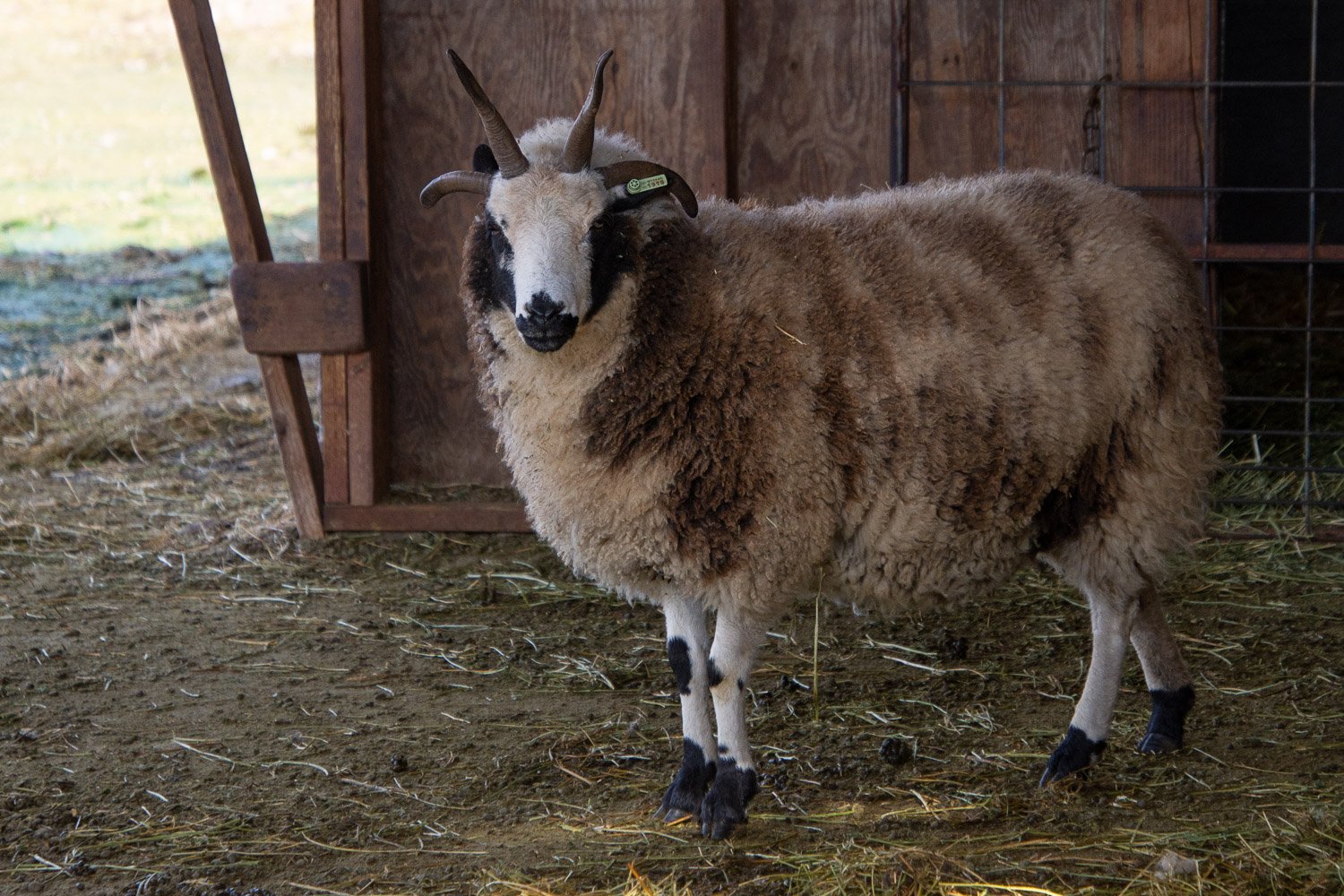
Sweetgrass Eilwen is Tranquility’s buddy.

Since I have gone off the original track to the sheep I bought this summer I thought I should be thorough. This is Hillside Gabby’s Barrett, a ram lamb who bred 7 or 8 ewes in October. I can’t wait for lambing!

Back to the home-grown sheep. This is Meridian Trina (Meridian Axle x Meridian Terri). You can see that her horns, although acceptable, are not as desirable. She is a 4-horn ewe with horns that are fused and therefore somewhat funky looking.

Trina’s dam is Meridian Terri, a ewe who also has fused horns on one side.

Look at Terri’s fleece. Isn’t that beautiful? It’s not all about the horns. There is a lot to try and get right with this breed.

Meridian Sonata is the oldest ewe here. She’ll be 10 when she lambs in March.

Meridian Sylvia is Sonata’s daughter. She has nice upper horns, but the lateral horns aren’t very stout. She was a ewe worth keeping though.

Soprano is another Sonata daughter. I don’t like putting coats on the sheep because I’d rather see the sheep than the coat (and it’s a lot of work to keep up with coats). But this fleece will be stunning because it will be so clean.
Maybe I’ll share more sheep photos tomorrow.
I had a couple of comments after the last post “A Ram Retrospective”. One person asked about Rotor. I couldn’t include all the rams I’ve ever had, but how could I forget Rotor?

Rotor had the unimaginable triumph of winning Supreme Champion Ram at the 2016 CA State Fair. That means the judge placed him over all the other breed champions. I don’t know what the talk in the barn was after that. Usually it’s one of the “regular” breeds that win.

This photo isn’t very sharp, but you get the feel of what the Supreme Champion competition looks like. Rotor and I are third from the left dwarfed by those huge rams, all perfectly fitted for the show. Jacob sheep are shown in a much more natural state, at least by those of us showing on the West Coast.

While I was looking for those last photos I came across this one. In the last blog there was a photo of Axle at almost three years and his horns had curled very close to his face. Axle was Breed Champion (Primitive Breeds) at the State Fair when he was a yearling.

At four months old his horns looked very promising. Many lambs are born with nice markings and good fleece, but a ram has to have horns that won’t impact his future well-being. With a two horn ram that means they need a nice wide spread.

Axle at 9 months.

Axle, almost three years. That horn on his right is getting pretty close to the jaw.
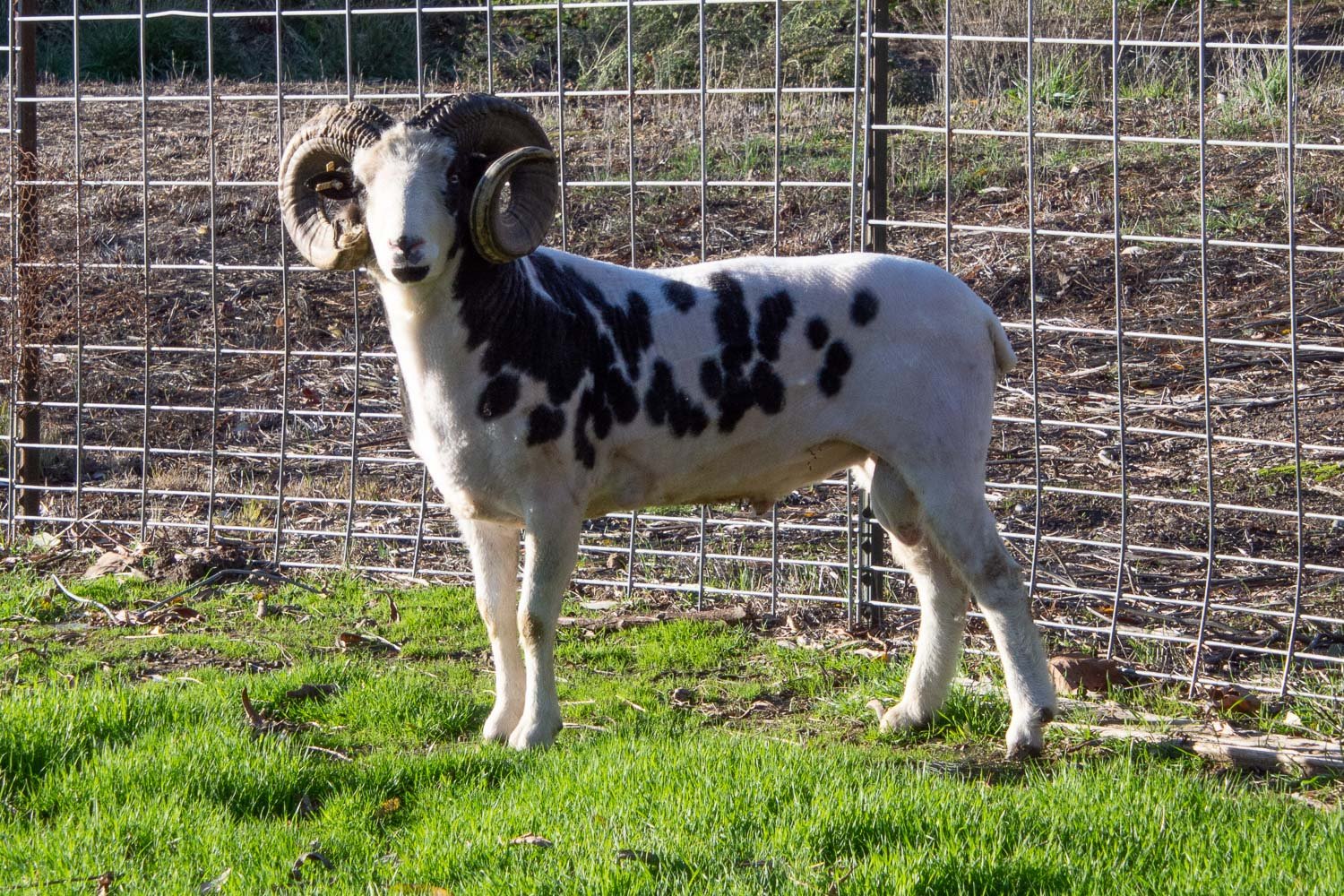
This photo was taken a few months after the last one. Axle has broken that right horn—I’m not sure how. Shortly after this he was sold to someone who was moving with her flock to Montana. Hopefully he is still there siring beautiful lambs.

I will remember Axle for the fun time we had at the 2019 Black Sheep Gathering Spinners Lead. I can’t imagine another of my rams standing so patiently on a halter with lots of other sheep around for the hour or so that we were lined up and waiting our turn. By the way, the scarves that he and I are wearing are his wool spun and woven that spring.
Axle has 7 or 8 offspring in the flock now.

Meridian Pecan…

and her twin Meridian Sandie.

Meridian Hazel, daughter of Axle and Jade, the most friendly sheep here. Hazel is #2 in line for scratches (and treats).
On Christmas Day I took advantage of my son being here to try and track down photos that seem to be “lost” in the depths of my computer. I’m still not sure we found the family photos I think are somewhere, but it prompted me to later go through other photos. I probably don’t really need all 33,000 that Lightroom says I have. There may be other posts like this one later, but I’ll start with rams. I think it’s always fun to see the variety in Jacob rams.

This is Jacquee’s Rugby. I think he might have been the first ram I bought, probably in 2001, because he sired lambs born in 2002 and 2003. I know I used a couple of other rams (from Hillside and Oak Farm) but I don’t find any photos of them. The photos here are of those I bought or that were born here.

Bide a wee Duke sired lambs in 2003 and 2004.

Meridian Apollo, born in 2004, sired lambs born in 2005 and 2006.

Hillside Joy’s Lynn, a lilac (the gray/brown coloration) ram who sired lambs born in 2005. By this time I was using at least two rams each breeding season and maybe more, but I don’t have photos of all of them.

Meridian Rocky (Meridian Apollo x Meridian Diamond) was born in 2006 but I don’t have a photo taken here. This was sent to me later by the person who eventually bought him. He sired Ranger, who is a few photos down.

Hillside Springtime’s Newberg sired lambs in 2007.

Bide a wee Yuri sired lambs born in 2008.

Chicory Lane Houdini was here for about half a year. He came to me because he had become aggressive and the owner needed him off the property. I used him for a breeding season and then didn’t want to risk the potential danger of keeping him around. This is an example of why I have very strong opinions about how rams should be handled while they are growing up.

As the flock grew Meridian Ranger (Meridian Rocky x Meridian Dot) sired a lot of lambs in 2008 and 2009.

Meridian Tioga was Ranger’s son, born in 2009. He sired a lot of the 2010 and 2011 lambs.

Puddleduck Ringo, born in 2014, is the sire of some ewes still in the flock, including everyone’s favorite pet, Jade.

Meridian Catalyst (Meridian Crosby x Meridian Clover) was a 2015 grandson of Yuri, in one of the photos above. Catalyst was a lilac ram who was eventually sold to another California breeder.

Bide a wee Buster, born in 2016, also sired many still in the flock.

Meridian Cayenne was the 2017 son of Catalyst and Mud Ranch’s Foxglove. He was that lilac color pattern with beautiful horns like his sire.

Meridian Jasper (Meridian Clark x Meridian Jade), is a grandson of both Buster and Ringo. He was born in 2019 and the sire of 6 or 7 sheep still in the flock. Jasper is now the flock sire of another California farm.

Meridan Axle (Meridian Catalyst x Meridian Ava) at almost 3 years. Axle was a favorite ram as far as his attitude and his fleece, and some of his offspring remain in the flock. I’ll share photos in another post of how fabulous his horns looked in his first year. This is an example of why you can’t always predict the final outcome of the horn growth. He is now at a farm in Montana but 5 of his offspring are here, including our second best pet sheep, Hazel.

Ruby Peak Tamarisk sired many of the 2021 lambs and we are awaiting more of his in 2022.
I went out for chores last night and was surprised to find this:

Of course it wasn’t in a pen with nice clean straw. I had no idea that there would be a lamb so I haven’t been watching for them.
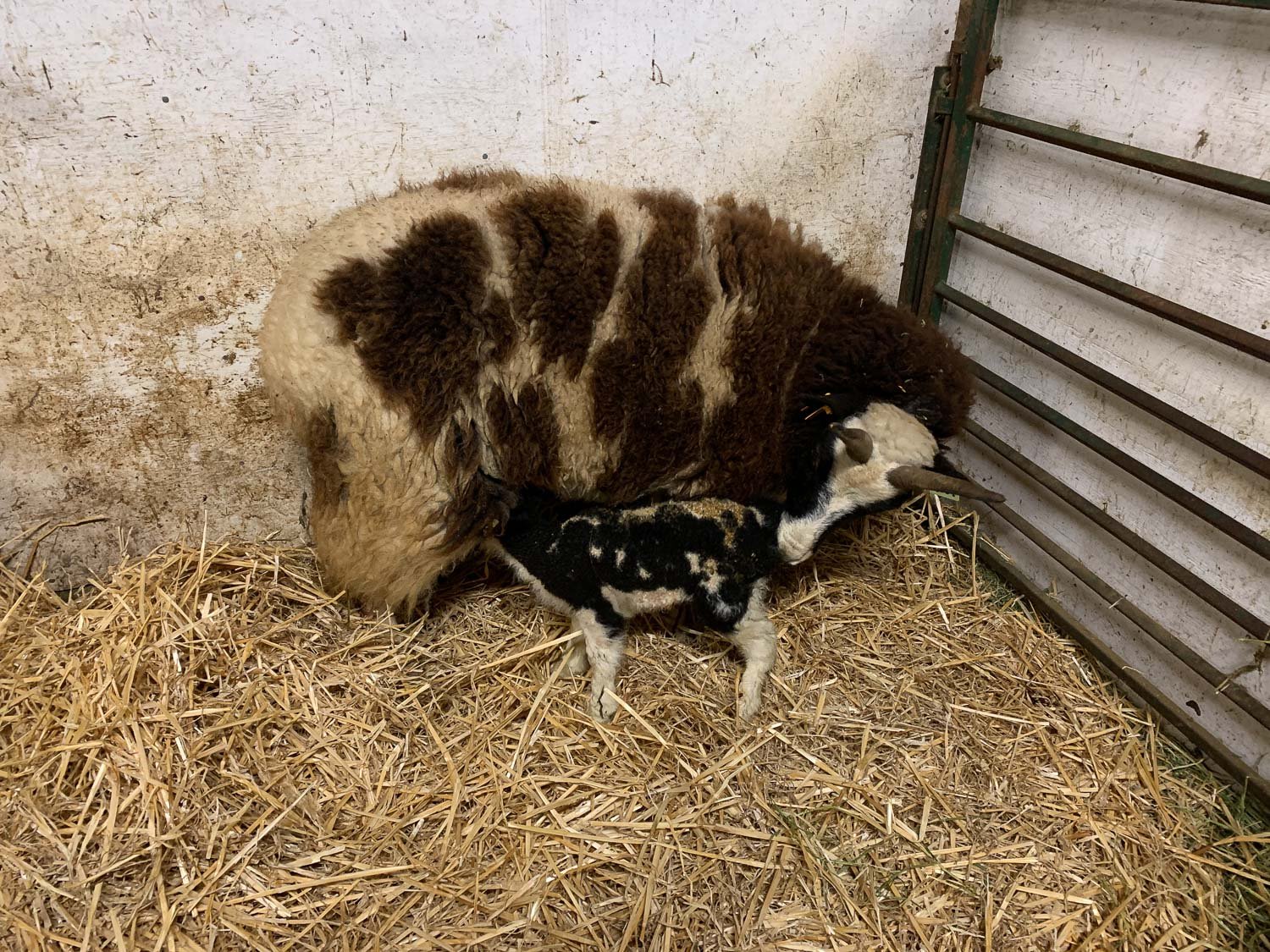
Lambs aren’t due until February 28. I checked back on my calendar 5 months and we were in Texas when this ewe would have been bred.

I checked with people who were here to find out if there were any break-outs (or break-ins) while we were gone and no one can think of anything. That means that I didn’t get all of the ram lambs out of the pasture when I had intended to. I meant to do it by the time they were four months old but I must have missed someone.

This ewe, Spice, is one of two ewes for whom I did not have a breeding date. The other has a fertility problem because she has never been bred and was confirmed open when we did ultrasounds a few weeks ago. The vets did ultrasounds on all the ewes and found 2 open that I thought would have been pregnant, but 52 other ewes that are pregnant.
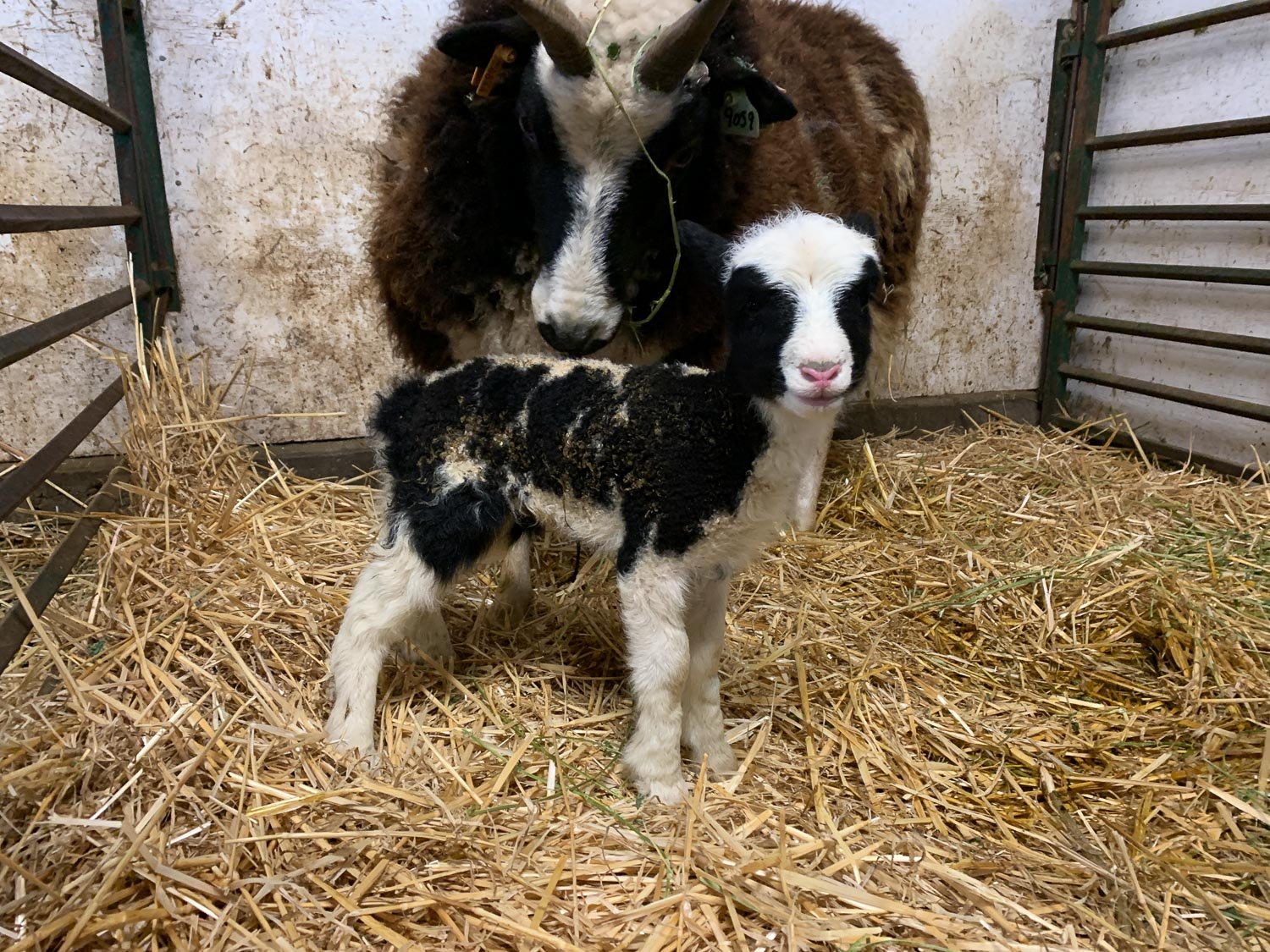
Farm Club members have suggested names: Yule and Surprise so far. I was wondering about OOPS!

After so many years of drought, maybe we’ll start to catch up. There is a lot of snow in the mountains and we got more rain yesterday. In the late October storm and this series of storms we have alsost more rainfall already than we got all last year. This photo is last night’s total. We had 3” a couple of days ago.

That much rain all at once makes for a mucky mess. Dan made a bridge for my wheelbarrow. This is why farmers don’t throw things away. That structure was one that has been around here for quite awhile—I think we may have got it from a friend when he moved years ago. It’s been the elevated path between the two houses since we had that October rain. Now it’s going to work as a bridge out here.

I looked at this view over the gate this morning and thought that the sheep looked very festive with their red and green markings.

One last photo. This was on Saturday as I was driving home from Sacramento. (Traffic was stopped so I as able to get this photo at no risk.)
In yesterday’s post I talked about trying to keep fleeces clean and mentioned the problem of the goats dropping hay on neighboring sheep. This morning I noticed this:

This is just what I mean about how goats eat.

Here is the other goat.

She turned her head to the side and dropped a big chunk of alfalfa on the sheep next to her.
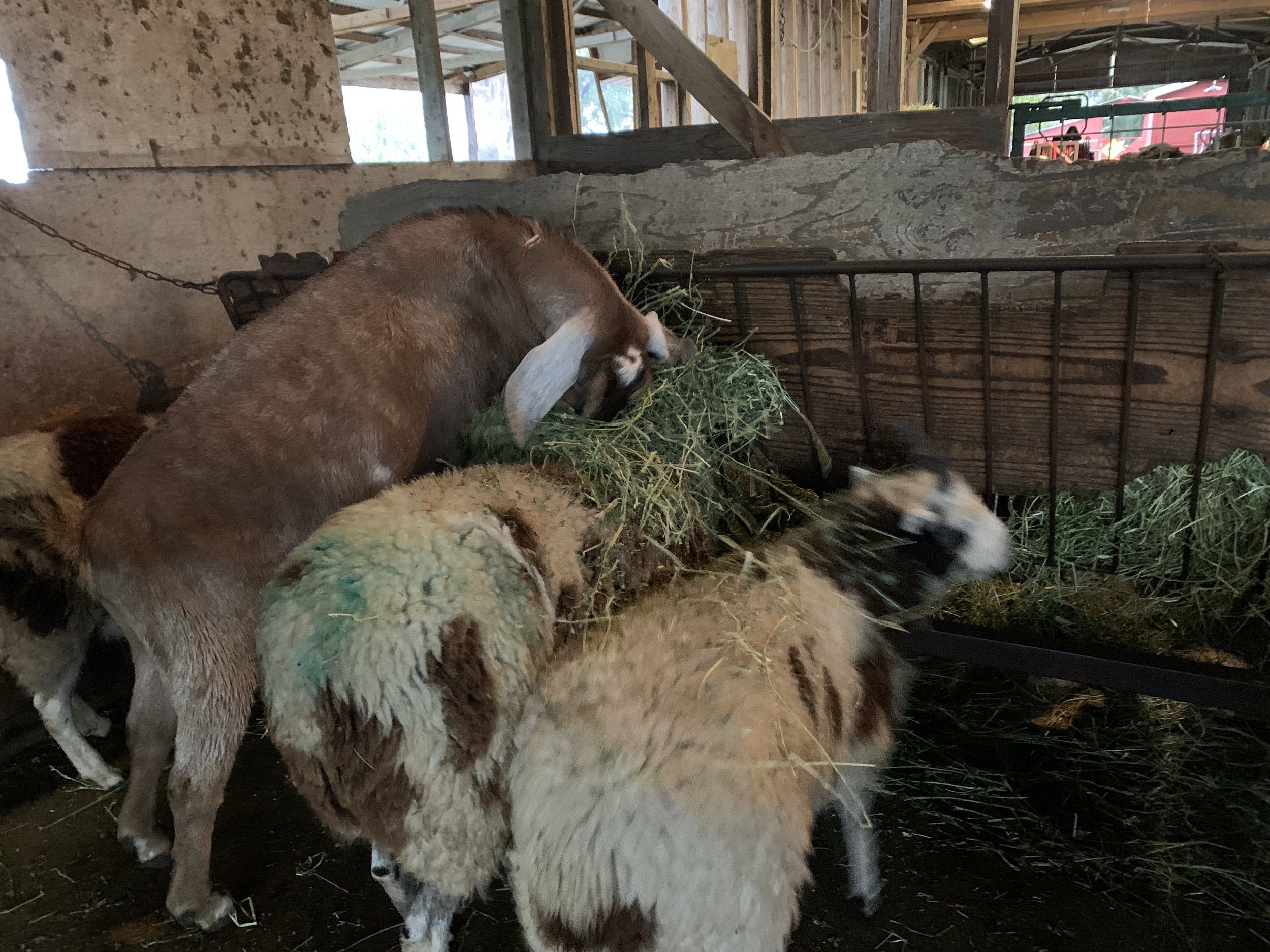
Not a good sight when I plan to shear soon.
I outsmarted the goats. They are now in another pen by themselves. I feel bad about that because they are not happy. But they have each other, there is plenty of room for two goats, and they won’t get into trouble. Maybe I’ll put the back with the sheep after shearing.
People always ask why some sheep have coats or covers. If you’re a spinner you know the answer. Spinners want to work with the cleanest wool possible. We’re not so worried about dust and dirt that accumulates from living outside. It’s the vegetable matter (known as VM) that is the problem. VM includes bits of alfalfa or grass hay in the fleeces of sheep fed in the barn or foxtails and other seedheads from pasture or range plants that have gone to seed. What do you know about seed dispersal? The most successful plants have developed means to get their seeds spread as far as possible. That often refers to foxtails or burrs or stickers that get caught in sheep fleece or your socks or your dogs’ fur. Washing does not remove VM. Some of it drops out with carding or combing, but much does not. In large (huge) commercial mills there are chemical processes to remove VM, but those are not available (or desirable) in our small and mid-size mills.
So how do we avoid contaminating fleeces?

KEEP HAY FROM DROPPING ON SHEEP. When I feed I chase them all out of the barn and close the gate. Then I put hay in the feeders before letting the sheep back in. At least that way I’m not dropping hay on sheep. Notice the wood panels in the feeders. The sheep feed from the base of the panels…EXCEPT for those sheep who insist on putting feet on the feeder and grabbing mouthfuls over the top. The goats do that all the time—grab a mouthful and then turn their heads and drop it on the nearest sheep. This is not a perfect system.

Coating sheep is another way to promote VM-free fleece. Some farmers who are well known for growing premium wool coat all their sheep. I choose a few to coat. It is usually those sheep that have been shown at a fair or fiber show. I use coats during transportation and at the show and then continue to coat them for the rest of the year. There have been no shows now for two years so I chose a few to coat anyway.
There are issues with coats. One is that I don’t like looking at coated sheep. I like the spots and the natural look of my sheep and that is how I’d rather see them. The other issue though is the amount of work involved. Not only do you need to change coats at least 3 or 4 times a year as the fleeces grow out, but there is a lot of coat maintenance, something that is worse when you have horned sheep. The coat on the sheep above is doing much good at this point.

Another problem coat. In this photo you can tell one of the benefits of coating sheep. The fleece maintains a darker color throughout because the tips aren’t sunbleached. This is a lilac sheep so her fleece is a brown color instead of black. You can tell the difference the coat makes by comparing the uncoated neck wool with what was under the coat that is now torn and dragging.

This is Quora, a ewe who will be two at her next shearing. The coat is not only torn but is getting too tight as the wool grows. This photo was from August of this year.

Here is how the fleece looks.

These are the coats I replaced earlier in the year. These have all been washed but now need to be repaired. I do not have an industrial sewing machine and a home machine can only do so much. I can sew rips and use patches, but it gets tricky when you have seams in multiple layers of thick fabric.

I changed four coats this morning. This is Quora, the ewe whose torn coat was replaced in August. This one is getting tight around the neck and is also torn.
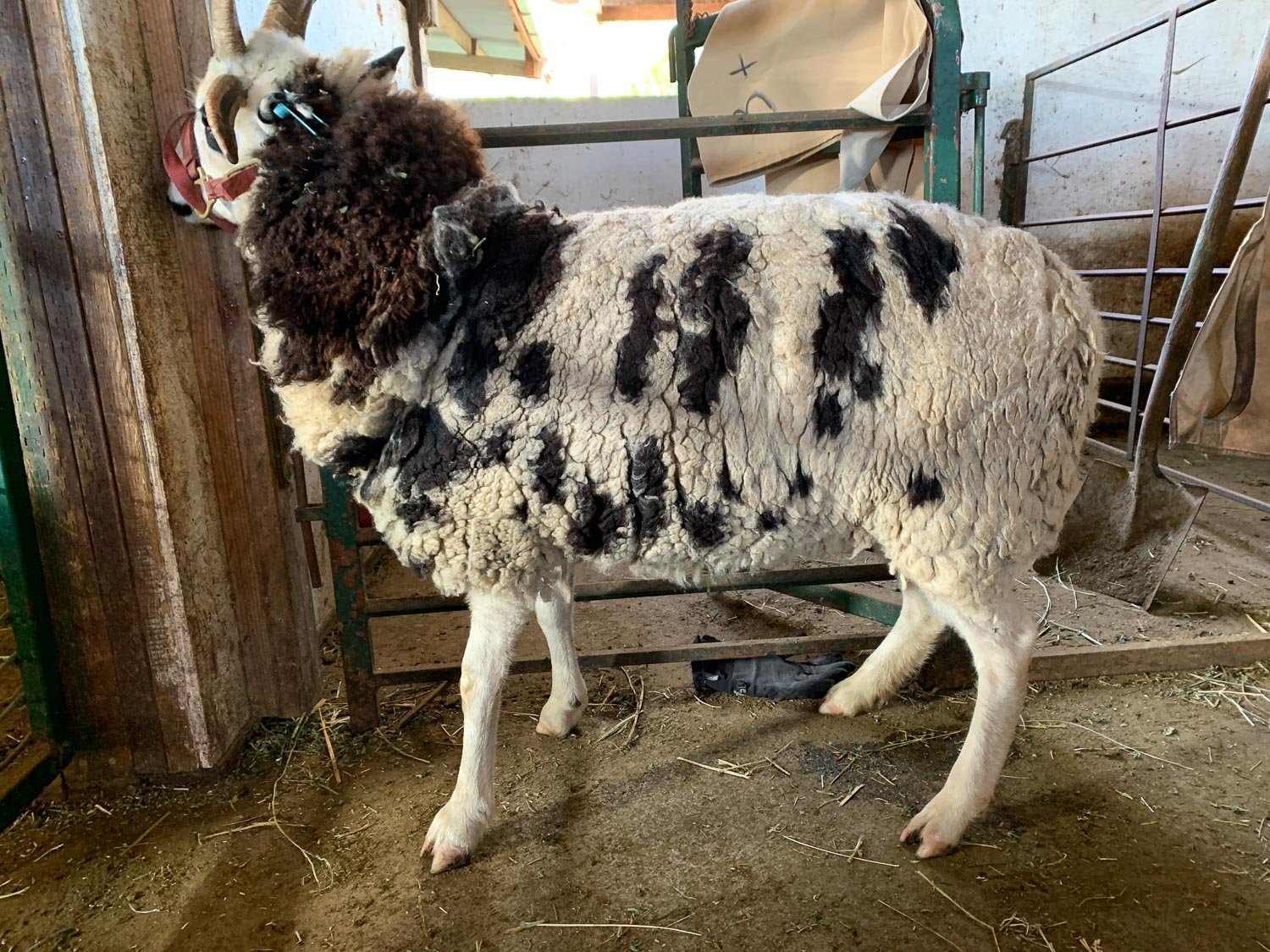
Notice the true black color where the coat was protecting the wool.

I may need to claim this fleece for myself.

Here’s the new coat—Size 4+ .

I don’t have a photo of this ewe, Pecan, before removing the coat but you can see from the neck and tail now tight that coat was on her. Pecan is another lilac ewe (that gray brown color instead of black).

Pecan’s fleece. Wait! Maybe I need to keep this one.

Pecan in her new coat—still sort of tight on that fleece. We have 7 weeks until shearing. Can this coat last?

This is Pecan’s twin, Sandie, with her coat removed. Her fleece is still in good shape, but when coats get too tight they can contribute to felting on the sheep.

Sandie’s fleece.

Sandie’s new coat.

Soprano’s coat wasn’t as tight as some of the others, but it definitely needs repair.

Soprano’s fleece.
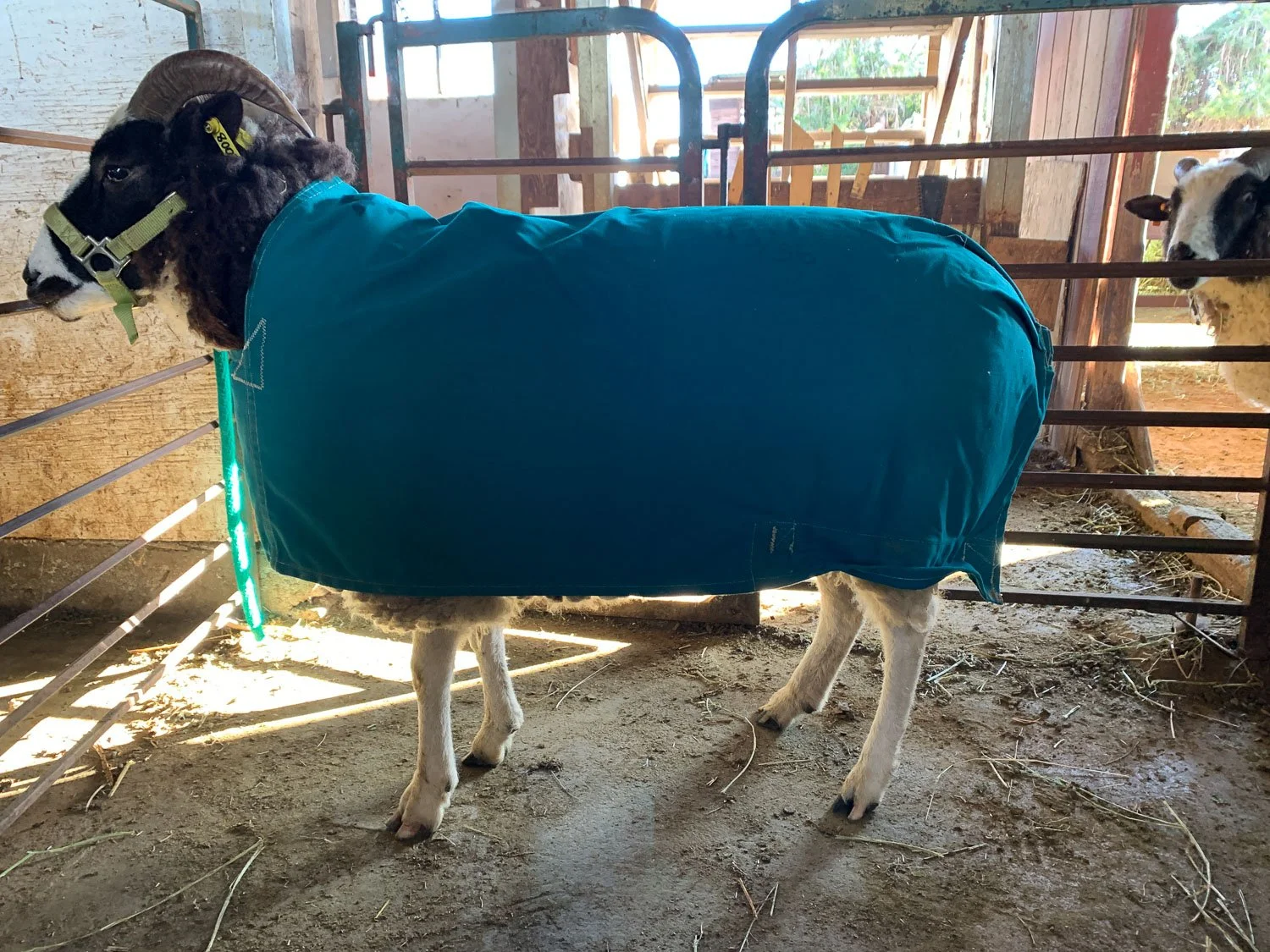
This coat is a better fit and has no repairs… yet.

These are the four ewes whose coats were changed today. I think there are two or three other coated sheep in the flock.
I’m organizing some of my photos and have a lot I took thinking of blog posts but I never wrote those posts. Here we go with some of the more recent Random Farm Photos.

Quinci is one of the 2021 ewe lambs born in March. Look at that fleece! We will shear in about 2-1/2 months and we’ll have some gorgeous fleeces.

This is the fleece of another ewe lamb who has mostly dark fiber.

Coating the sheep keeps the fleeces beautifully clean—free of VM (vegetable matter, which is usually hay in our system). But the problem with coats is that there is a lot of maintenance, especially in a horned breed. Coats need changing at least 3 or 4 times a year as the fleece grows in addition to when they are too torn to stay on the sheep. This is a patch job by one of the Farm Club members. Besides I don’t really like seeing them in coats. I’d rather see their wool. I always have a few though to have those wonderful clean fleeces.
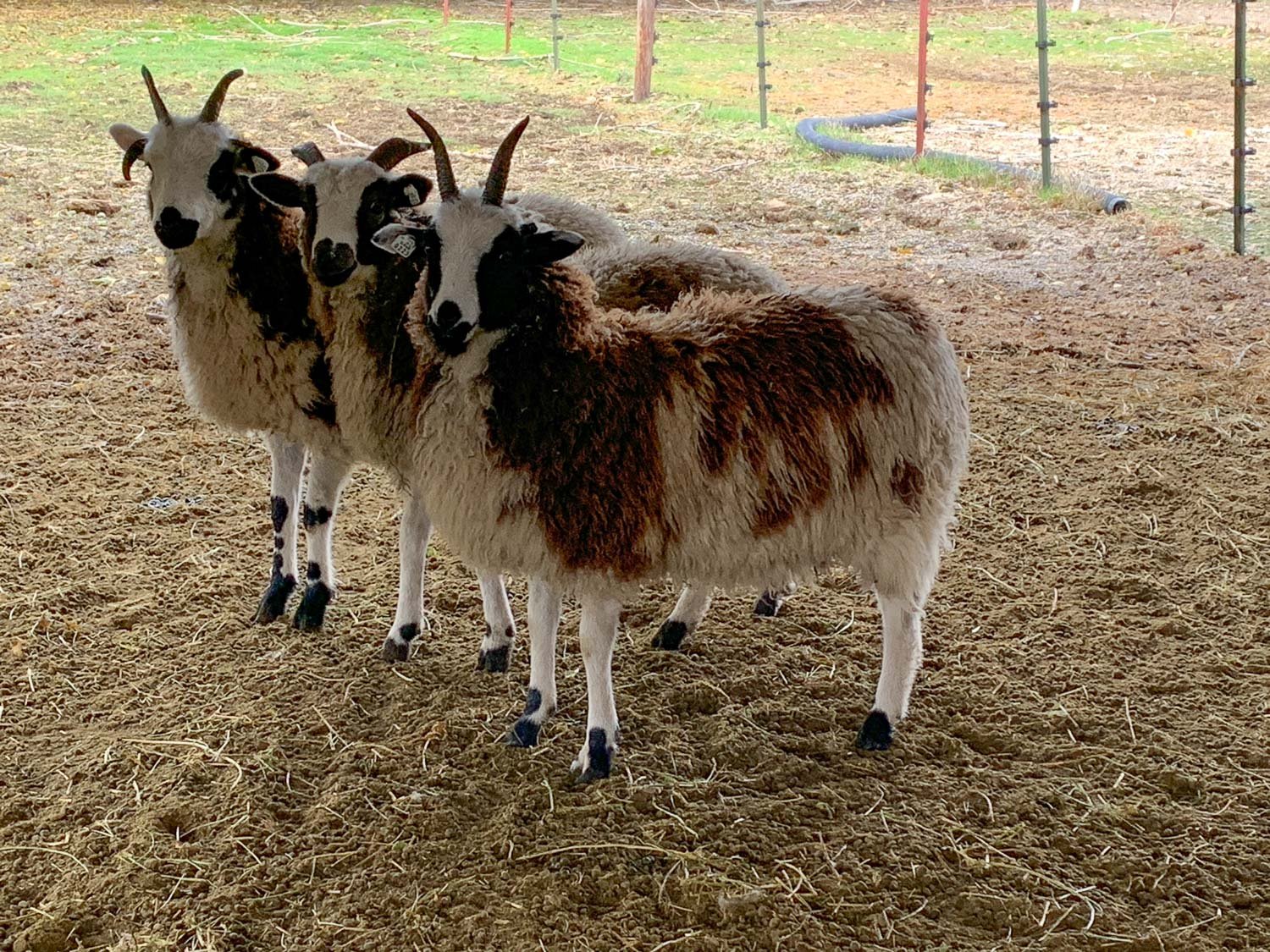
Do you remember these three? I introduced them awhile ago. I got these ewe lambs in August and they are usually found together. From back to front that’s Hillside Grace, Patchwork Amara, and Patchwork Bettylou.

Ewes heading to pasture on an overcast morning.

This one is in the category of “sheep problem”. I had just put the two tame wethers in a separate area. Why this one decided he needed to be IN the feeder I don’t know. I couldn’t get him out without calling Dan. He couldn’t go forward because his hips were stuck. I couldn’t pull him out by myself. We did get him out and I put that feeder on its side for now so he wouldn’t try that again.

Another sheep problem. I found this after I put the rams back together. This is Barrett, the smallest ram. I had forgotten to take his marking harness off but that wasn’t the problem here. He got his head through the welded wire panel and couldn’t pull it out. It took two of us to manipulate his head just right while pushing on the wire to get him out.
These are examples of why it is a little worrisome when we leave and I am asking other people to take care of things here. In fact, I think it was when we were in Texas this summer that one of my friends had to deal with the sheep-in-the-feeder problem—same feeder, different sheep. She had to call on another friend who came over to help get the sheep out.

This is Meridian Silverado, Meridian Dylan, and Hillside Barrett. Barrett is the lamb with his head in the fence in the last photo. Dylan is now living in Nevada, and Silverado is here.

Axis is the other ram lamb who is staying here.
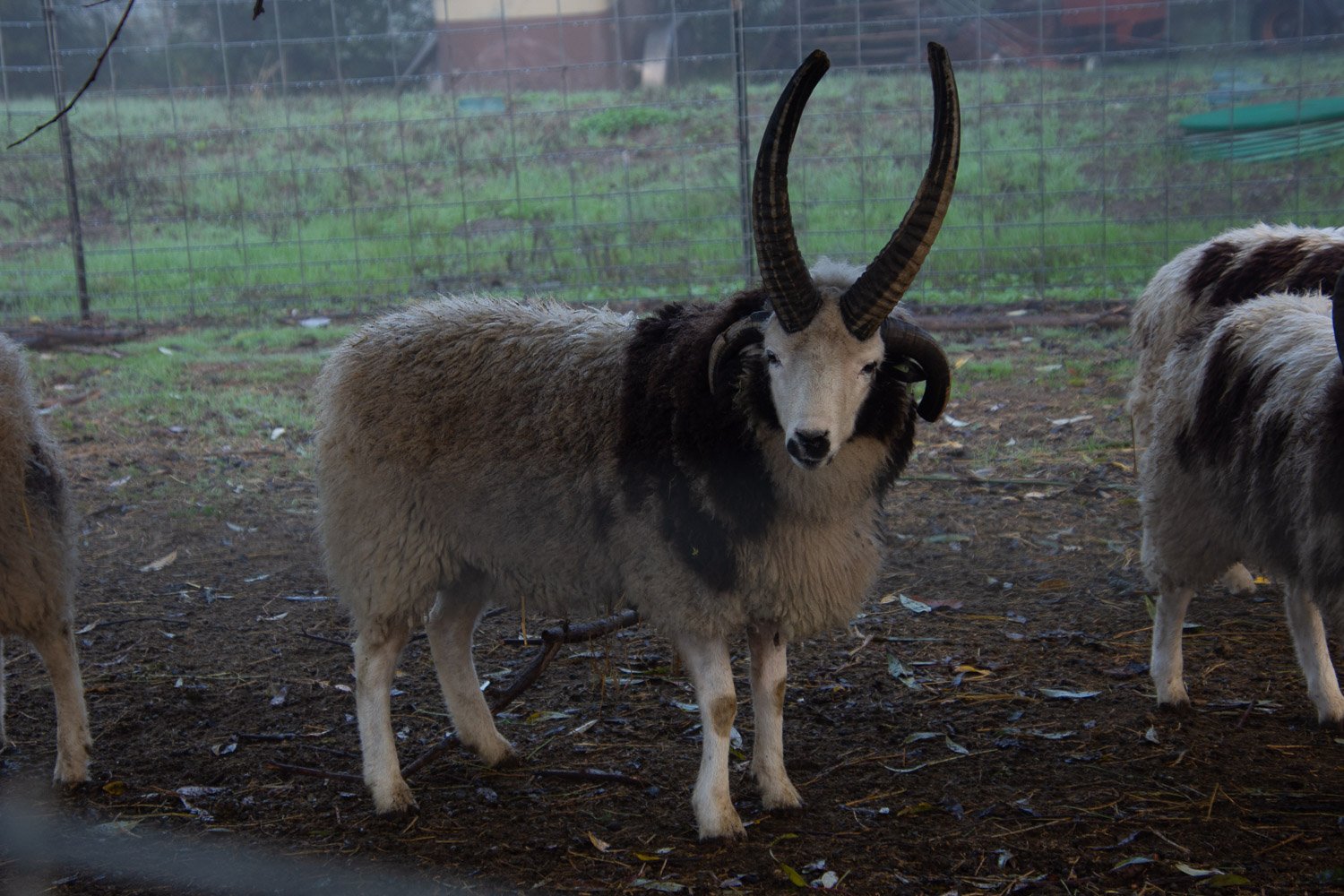
Rambler is the yearling ram.

One last photo. This is Sunny lying on top of me.
At the end of Part 1 I asked a question about the Scottish bagpipers. Did you figure it out? See the next photo.

At first I thought it was just a few, but they all had sheep covers on their bagpipes.

The crowd was asked to be quiet while the sheep trailed through town. There are two sheep with halters at the front of the herd. The woman leading them was introduced as being part of this since being a little girl with her pet sheep. It helps sheep to have another sheep to follow so I assume that maybe at the staging area it was helpful to have these tame sheep be part of the plan. Maybe if we go again we’ll watch from that area—that would be interesting.
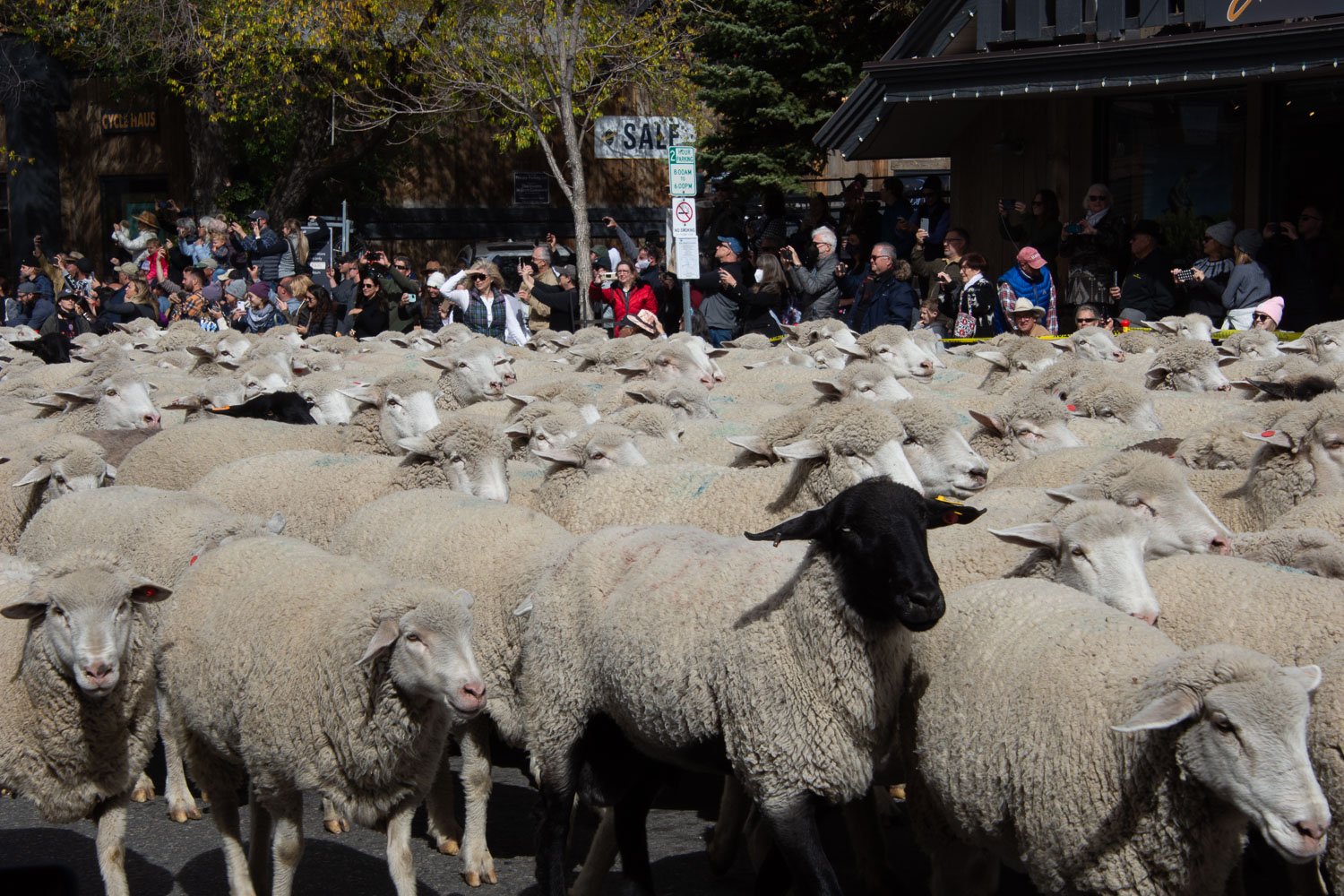

The sheep were followed by two more sheep camps, each a more modern version than the horse drawn camps.

I think this was an official part of the parade and he didn’t just sneak in to try and make a sale.

The last “entry” was the street sweeper.

After the parade we walked through a small outdoor vendor area. There were pushpins so that attendees could mark their locations on this map.

There were booths selling sheep and wool related items.


I stopped here because I thought I recognized the yarn. Not the actual yarn, but the style. Sure enough it was spun at Mountain Meadow Mill in Wyoming where my Timm Ranch yarn is spun. The wool comes from Nevada and one of the family members is working with this vendor to market the wool as yarn and as blankets.

They found a weaver in Boise. This made me anxious to get home and get my AVL loom up and running again. I’ve had glitches with the new compudobby (probably my fault and not the loom’s) and have been avoiding it. I have the yarn and I have the loom and I really want to get back to weaving blankets.

Seen on the way out of town.

Moving on from sheep, also seen on the way out of town.


This very cool set of bronze statues is at the south end of Hailey. I couldn’t get a decent photo of the whole thing. There is a herder with his horse, a dog, and several sheep. The artists’ portrayal of the animals’ body language and movement is just perfect. I can see my sheep turning like that to the dog, who crouches down to encourage the sheep to turn around (or in Ginny’s case, she’d bark and the sheep would turn around and stare).

In this view the dog and the herder are at the back.

On the long road to home. We hadn’t decided if we were going to stop along the way or just make it home.

A call from the Artery made that decision. I was supposed to work my shift Monday morning at 9:30. I think I hadn’t written in down because I knew that I should trade with someone for that day. Oops! We drove and made it home at 12:30 a.m.
We ended the second day in Idaho by loading up Chris’ motorcycle and some other belongings that we would transport back to California. Then we hit the road and ended up in a motel sometime after dark. The next day we drove to Ketchum to catch the parade that is on the last day of the Trailing of the Sheep Festival.

We were rewarded for not driving this part of the route in the dark by seeing the fall colors along the way.

This is the town of Hailey and some of the Trailing of the Sheep Festival activities were here. Sheep played an important role in the economy and history of this part of Idaho. The amount of money represented by the sheep market from the mid 1800s to mid 1900s and beyond is in the billions in today’s dollars.

Now it’s not all about sheep, especially in this valley where winter sports and recreation have a large role. As you know if you follow my blog I keep myself amused by taking photos of things of interest along the way…things like a giant bicycle…

…and a colorful sheep.

Ketchum is just up the valley from Hailey. We parked outside of town and walked to the parade route. Like any other small town parade, people had staked out their spots with lawn chairs. We found a spot with a view and waited for about 45 minutes for the parade to begin. The sheep spend the summer grazing in the high mountains and are trailed down the valley to lower elevation for the winter. This festival was developed as a way to recognize this history and the people involved and promote the concept to the modern residents.

A mounted color guard. The horses were decorated with sparkly rumps, but I already have enough photos to share so I didn’t include that one.

The dignitaries of the town and the parade were transported in the first horse drawn wagon. This is the Lava Lake Lamb Camp wagon from Hailey.
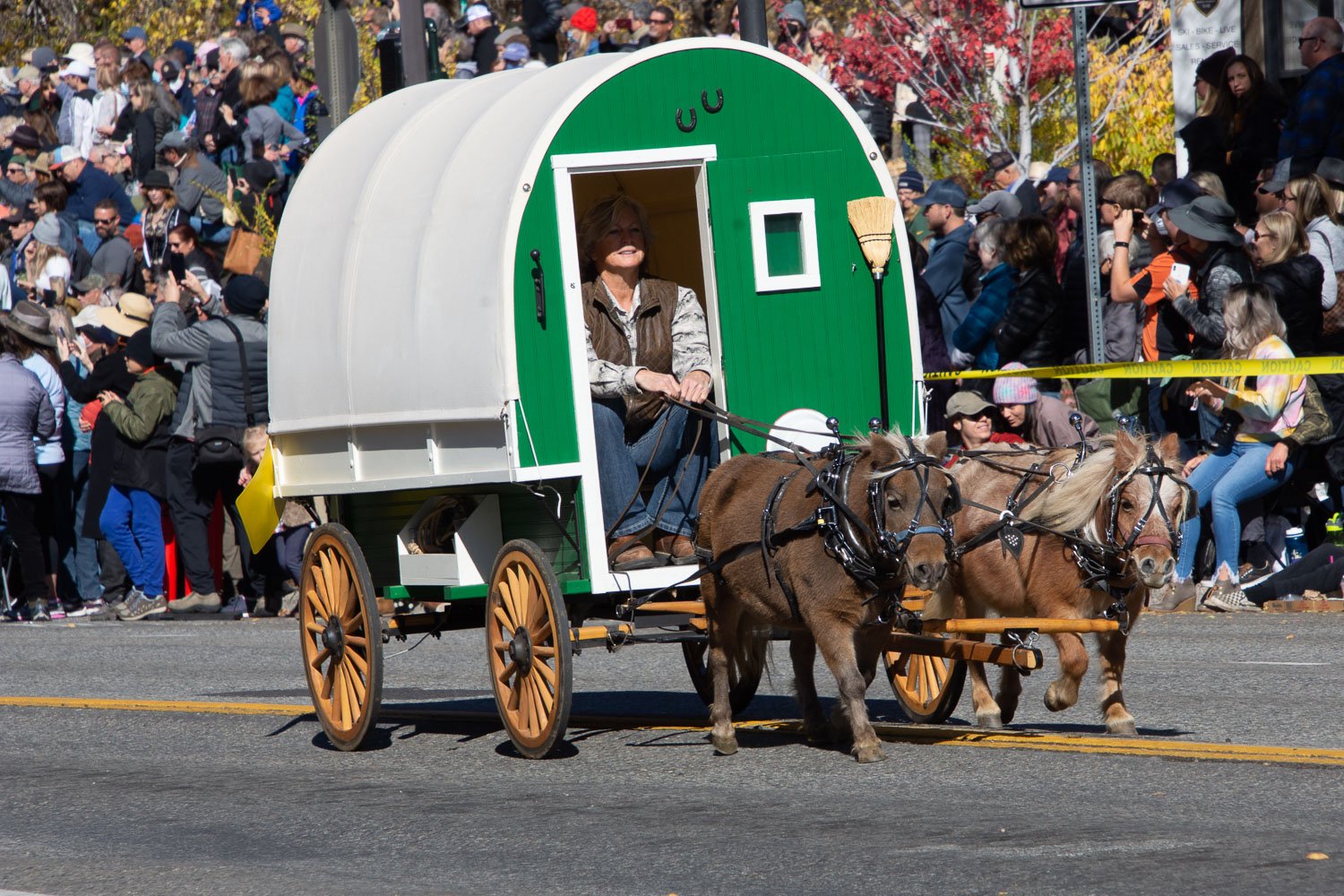
Hook Lamb camp wagon pulled by miniature horses.

This is the Jones Sheep Camp. They call these wagons camps because they are the basis of the headquarters or camp for the shepherds who stay with the flocks in the mountains all summer.

The Ben Holland Sheep Camp, with a double wagon.

The parade included Basque and Peruvian dancers and musicians and the festival recognized the importance of those cultures to the sheep industry . Many of the original Basque herders settled in the valley and became sheep owners themselves. Today the industry relies on Peruvian herders.

This is Miss Lamb Chops and I don’t know the story about her.

It seems that where you find a wool celebration you often find a Scottish component. Scots settled in the valley and played an important role in the early days.
I saved way too many photos for this blog post so I’m going to make this Part 1 and finish it off with Part 2. While you’re waiting for that, take a look at these bagpipers. Do you notice anything odd?
To be continued…
We live by seasons…and this one is breeding season.
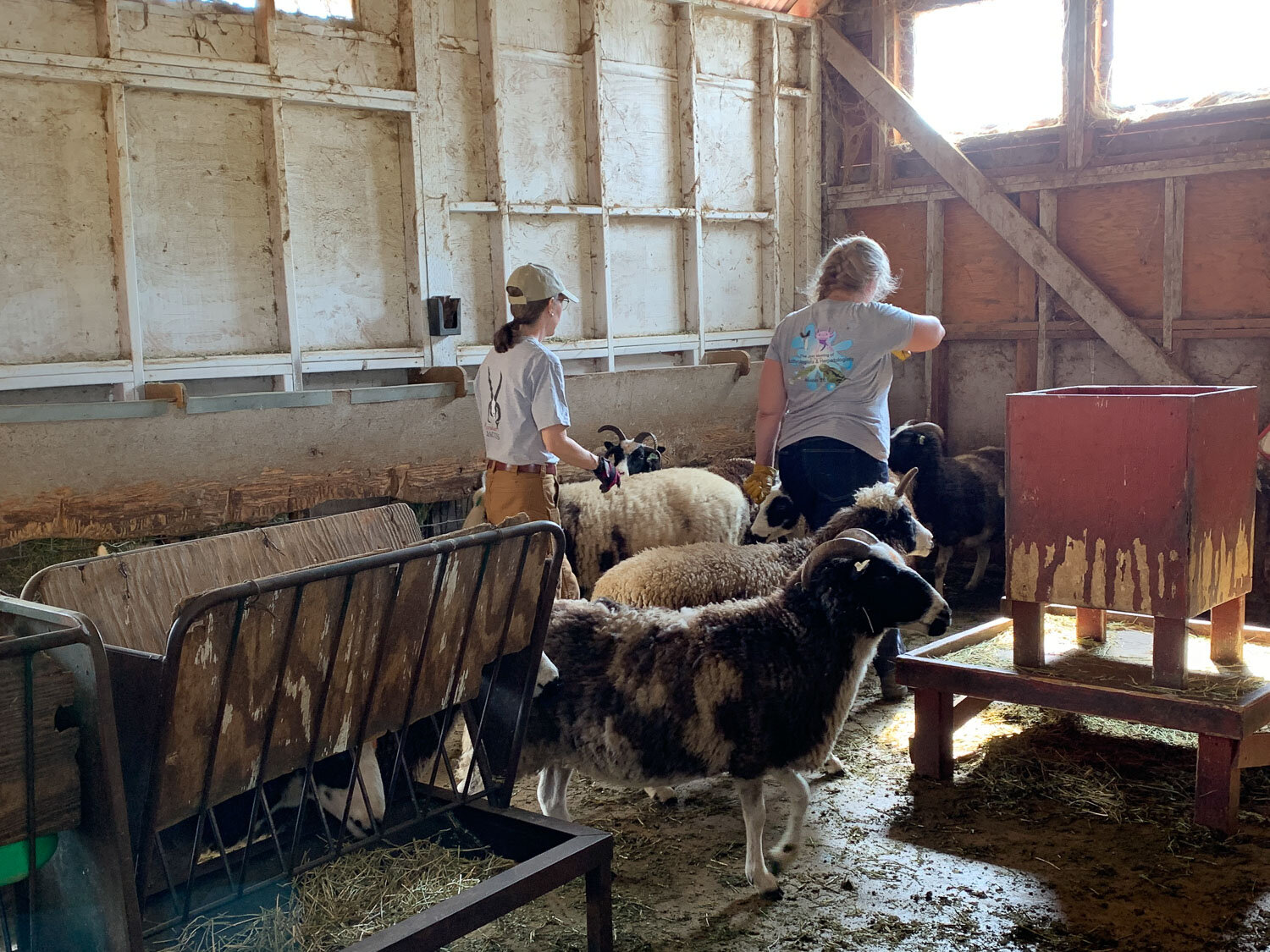
On Sunday Farm Club members came to help. We started by sorting ewes. We also replaced old smaller ear tags with some that are a little larger and more legible. We colored coded the 2018 and 2019 ear tags. I had already tagged the 2020 ewes with blue tags. I can identify many of the sheep by their markings but I don’t remember all 60+ of them. The larger ear tags make it easier to read the tag and to find a particular sheep when you can narrow down the year by the ear tag color.

Then we put the markers in the ram harnesses.
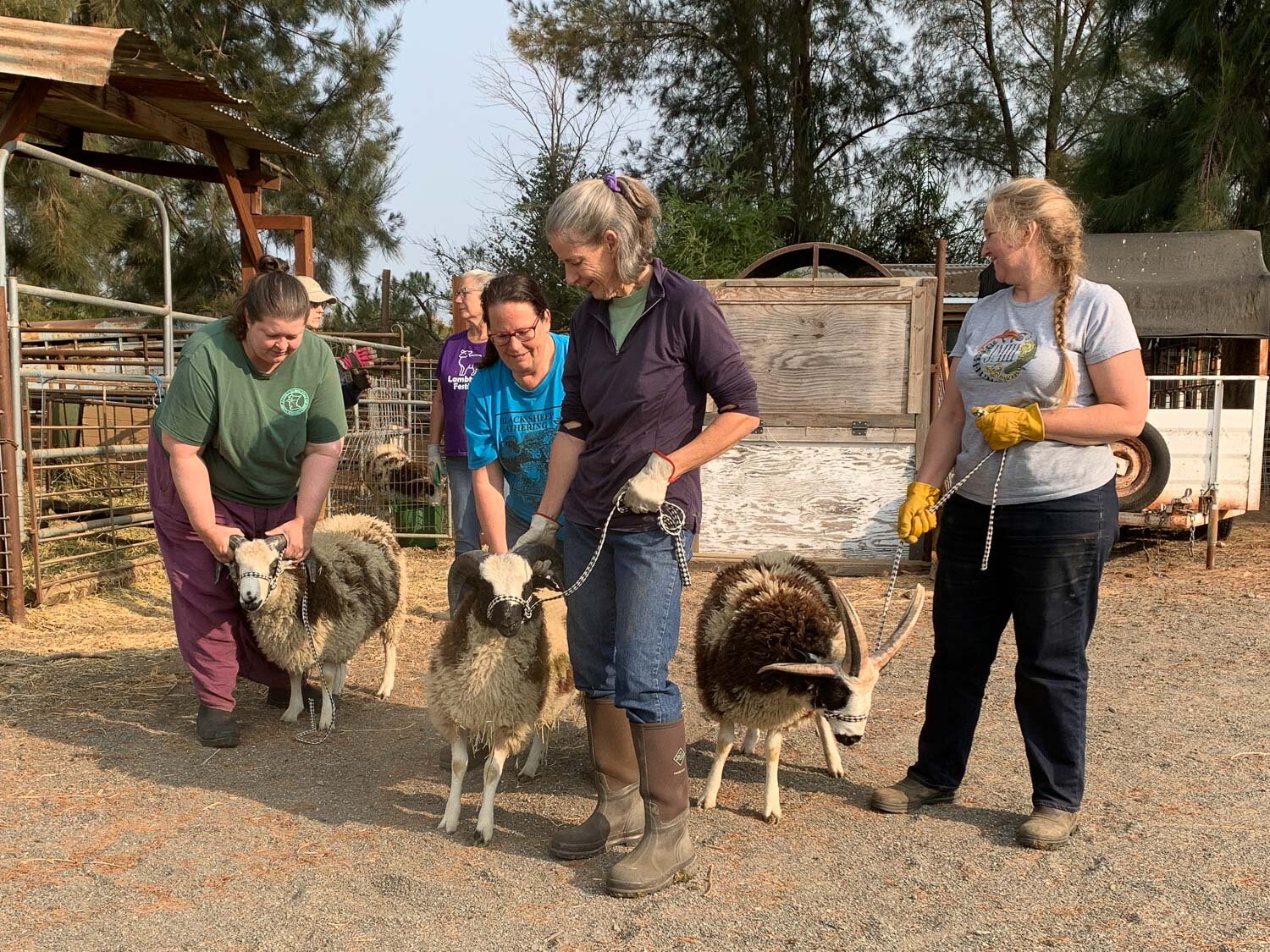
It was time to get the rams. Farm Club members went to get the ram lambs. I had worked with Axis (left) and Silverado (right) a bit…

…but Barrett is the new one and he thought dragging was the way to go rather than walking…

…or maybe giving up was best.

We had planned a break at 10:00 to watch the Lambtown Sheep-to-Shawl judging. We missed the first part so didn’t hear what most of what they said about ours—we can watch the recording when it’s posted.

The judging presentation was good, but unfortunately our shawl was among the four that were disqualified based on size. We were short of the desired 72” by only about 2”. I guess we were in good company. Back to work.

The lamb, Axis, got down to business right away.

The youngest one, Barrett, was interested but the ewes wanted nothing to do with him. In cases you’re wondering, it’s not that he’s too little, it’s just that they aren’t in heat right now.

Dan and I caught the big rams.

Tamarisk’s face has been looking a little rough, but he seems OK other than something under his jaw. (Thanks for the photos Susan.)

I caught him about a week ago to check out his swollen face. He has something going on with his jaw but I think that whatever it is has healed—it’s hard like bone, not soft like an abscess. He still eats and is in good flesh.

If there is something with his jaw it’s not on his mind right now.

I had to chase this group out to the pasture because they got distracted by each other and were just hanging around the lane.
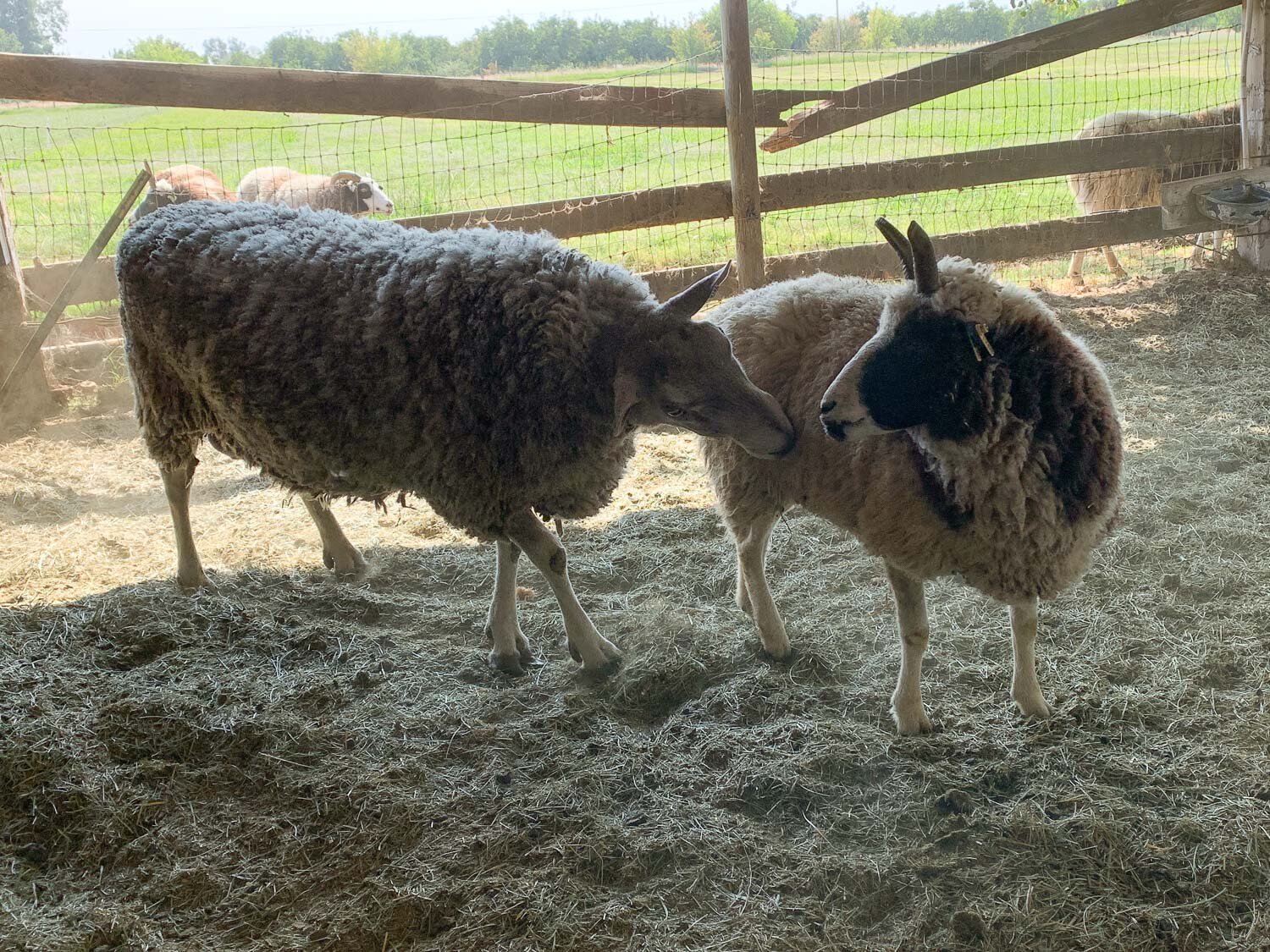
Peyton was happy to have some female company.

Ram lamb, Silverado, seemed more interested in the smells in the ram pen where the older rams had been.

Rambler’s group also has a pasture that is separate from Tamarisk but they can also go into the corral near the barn.

Everybody’s favorite ewe, Jade, was the first to be marked.

Rambler, Tamarisk, and Peyton all wore themselves out on Sunday afternoon. Among them 10 ewes were already marked.


I have two extra ram lambs, Dylan with 4 horns and Orion with 2 horns. They are both for sale as registered breeding rams.

This is the third day the rams have been with the ewes. Tamarisk has bred 10 of his group of 21 so far.

Peyton has bred 4 of his 5 ewes.

Axis is a lilac ram with some of the lilac ewes and ewes that carry lilac in their pedigrees.


He has marked Zora, left, and Foxy, right and 2 other ewes so far.

I’m still waiting for Barrett (in this photo) and Silverado to mark someone. Maybe tonight.
I was was frustrated over some tech issues I was having yesterday and decided that my sheep and my camera would help me get over it. So…

I’ll start with the rams. This is Orion, a ram lamb that is for sale. I love that wide horn spread.

Dylan, a nice ram lamb, but not on the breeding line-up.

Axis is a lilac ram lamb who will have a group of ewes.
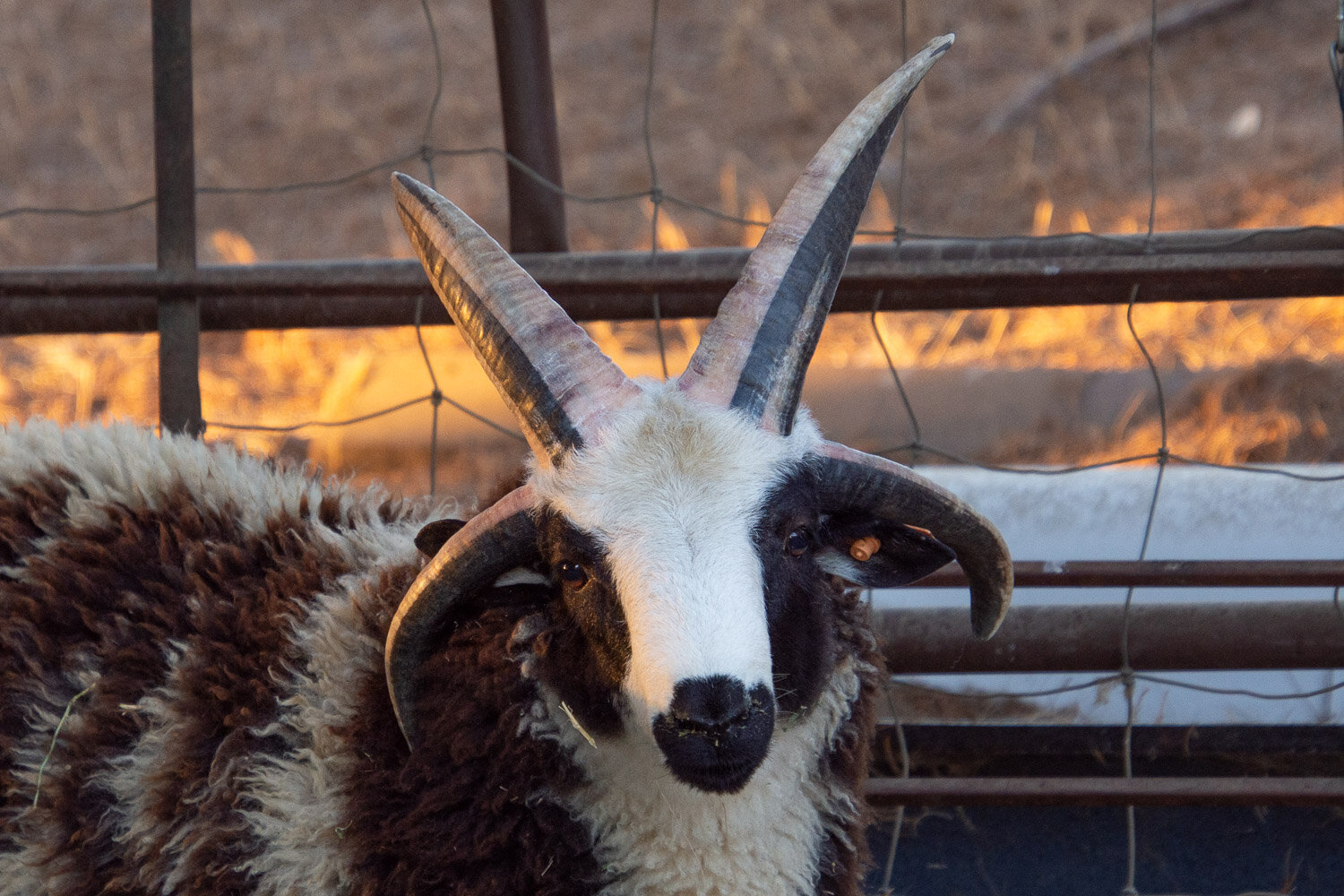
Silverado will have a group of ewes.

Hillside Barrett is the only one who wasn’t born here. He came from Michigan last month. He is younger than the others but will have a few ewes.

Billy is a wether who is kept around as a buddy for a sheep that needs to be separated from the others for some reason. He was with Barrett when he first came and now is with Dylan. Dylan just came back from a friend’s farm and I don’t want to deal with the fighting that there would be if I put him in directly with those other rams.

Speaking of wethers, here is Rocky. A wether’s horns stop growing at the rate they would have grown if he was still a ram. These horns would have prevented registration for this guy. I needed a wether a few years ago and he was handy. Now he is still here living the good life with nothing to do except eat and grow wool.

This wether does have a job. He is the full-time best friend of the BFL ram, Peyton, who I don’t want to put with the Jacob rams.
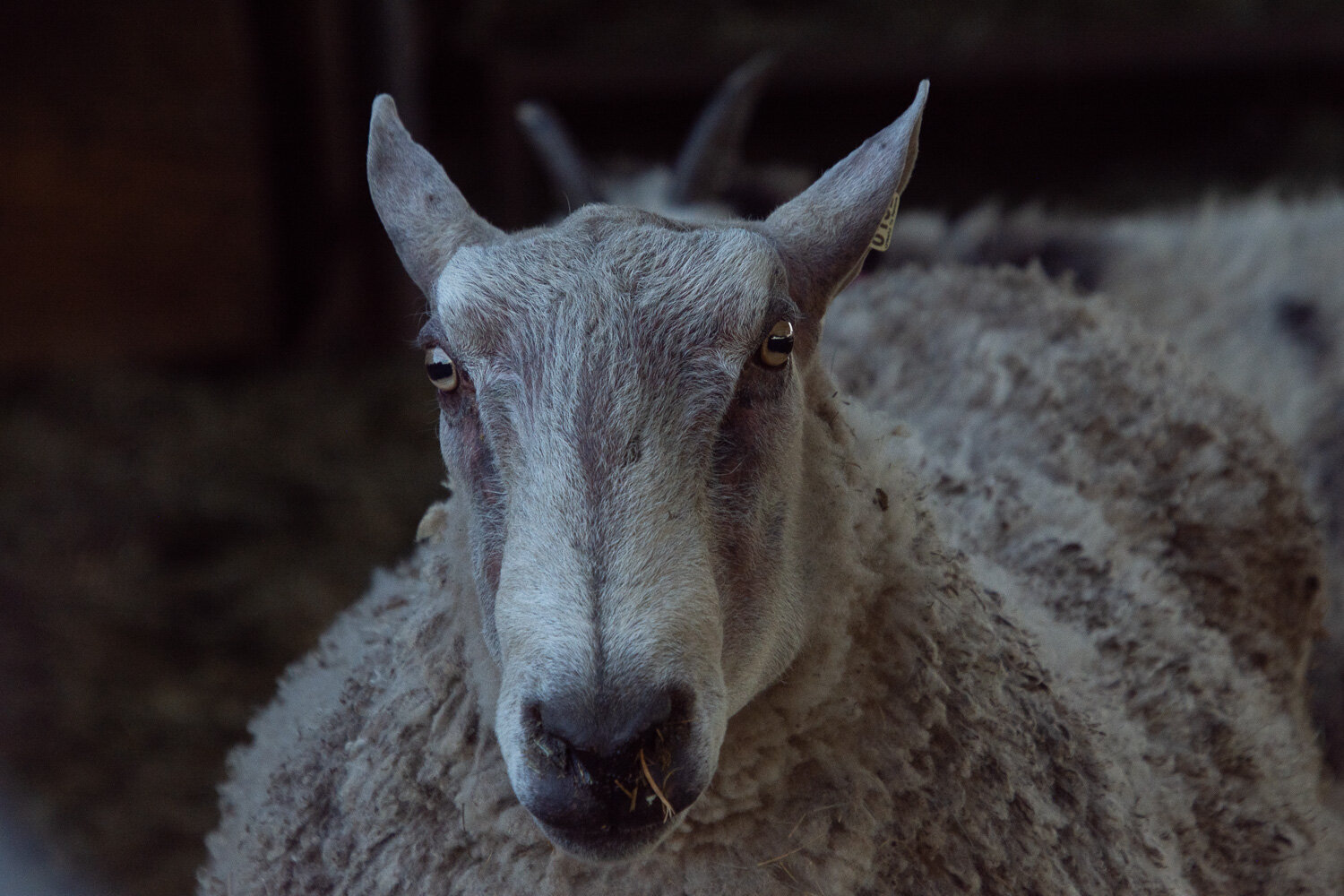
Speaking of Peyton, here is is. I liked this view best of the ones I took last night, except for the unfortunate location of the wether behind him—like the kid putting up “rabbit ears” behind someone in a family photo.

Rambler, the yearling ram. He’ll have a large group of ewes. So will Tamarisk, but I’m missing his photo.

Not a sheep, but a face. Ginny was posing on my way from the rams to the ewes.s

This is a yearling ewe, Pecan.

This is Pecan’s sister, Sandie. They happen to be two of the ewes whose fleeces I chose to protect with coats. Those fleeces will be sought after on Shearing Day in February.

A lilac ewe, Zora.

This is Patchwork BettyLou, one of the sweet lambs that came her last month.

Amelia, a Nubian doe. I love how expressive she is with those ears.

Sweetgrass Eilwen who came last month when I got those lambs.

This is Eilwen’s friend, Patchwork Tranquility.

Last but not least these are the three lambs that came last month. They are always together. Hillside Grace, Patchwork Amara, and Patchwork Bettylou.
A friend who raises Jacob sheep in Pennsylvania emailed me that a ewe that came from here won Champion Jacob ewe at the Garden State Sheep & Fiber Festival in New Jersey. Since all the shows I might have gone to out here were cancelled I’ll live vicariously through others’ fun events, and this news prompted me to write this blog post.

This is Royal Unzicker of Ivy Brook Meadows with Meridian Saffron. At the shows I attend in California and Oregon sheep are shown as lambs and yearlings, but Royal was able to enter Saffron in an Aged Ewe class at this show. (Thanks to Brittany Smith for this photo and the one of the ram.)
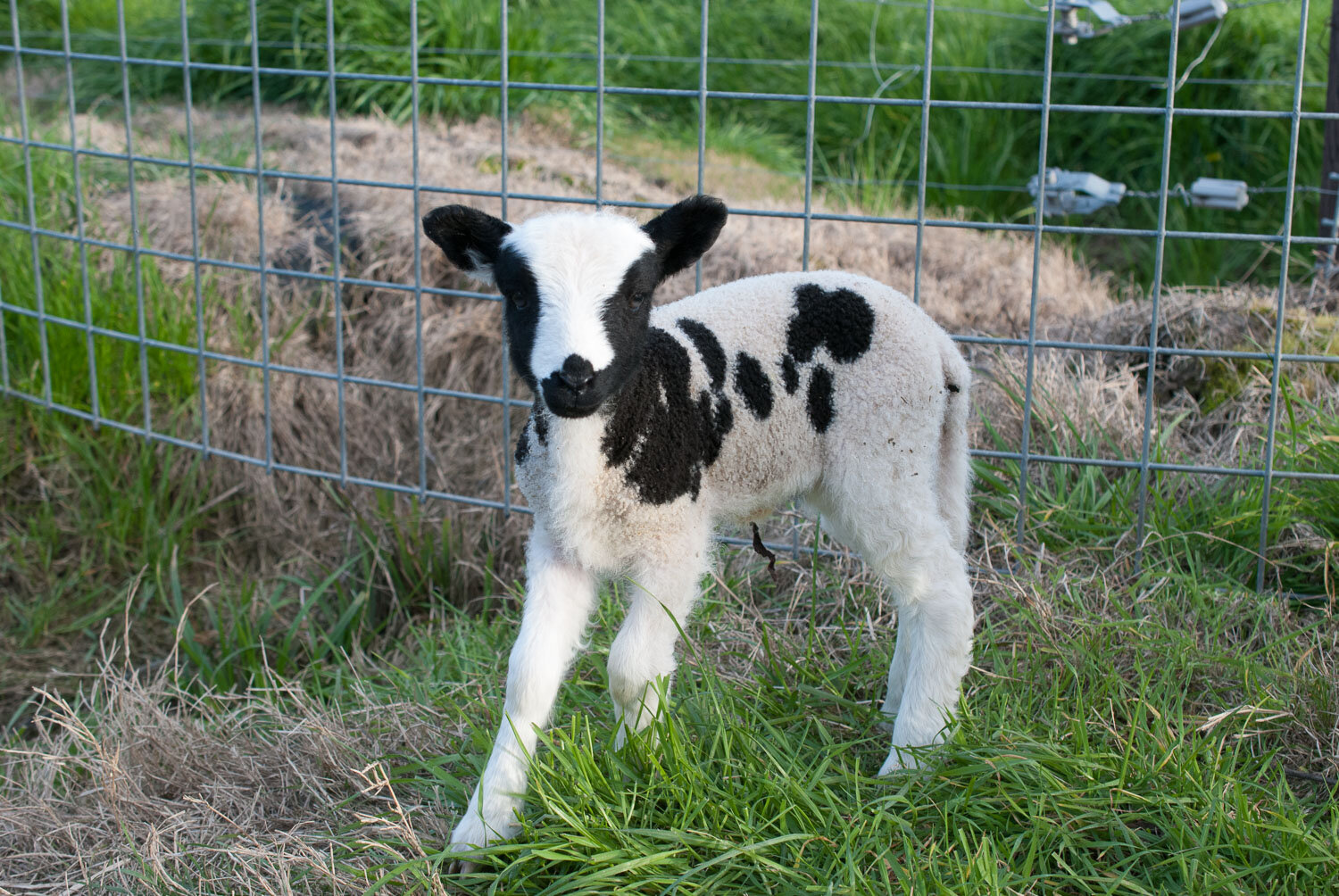
Here is a baby picture of Saffron in 2017.
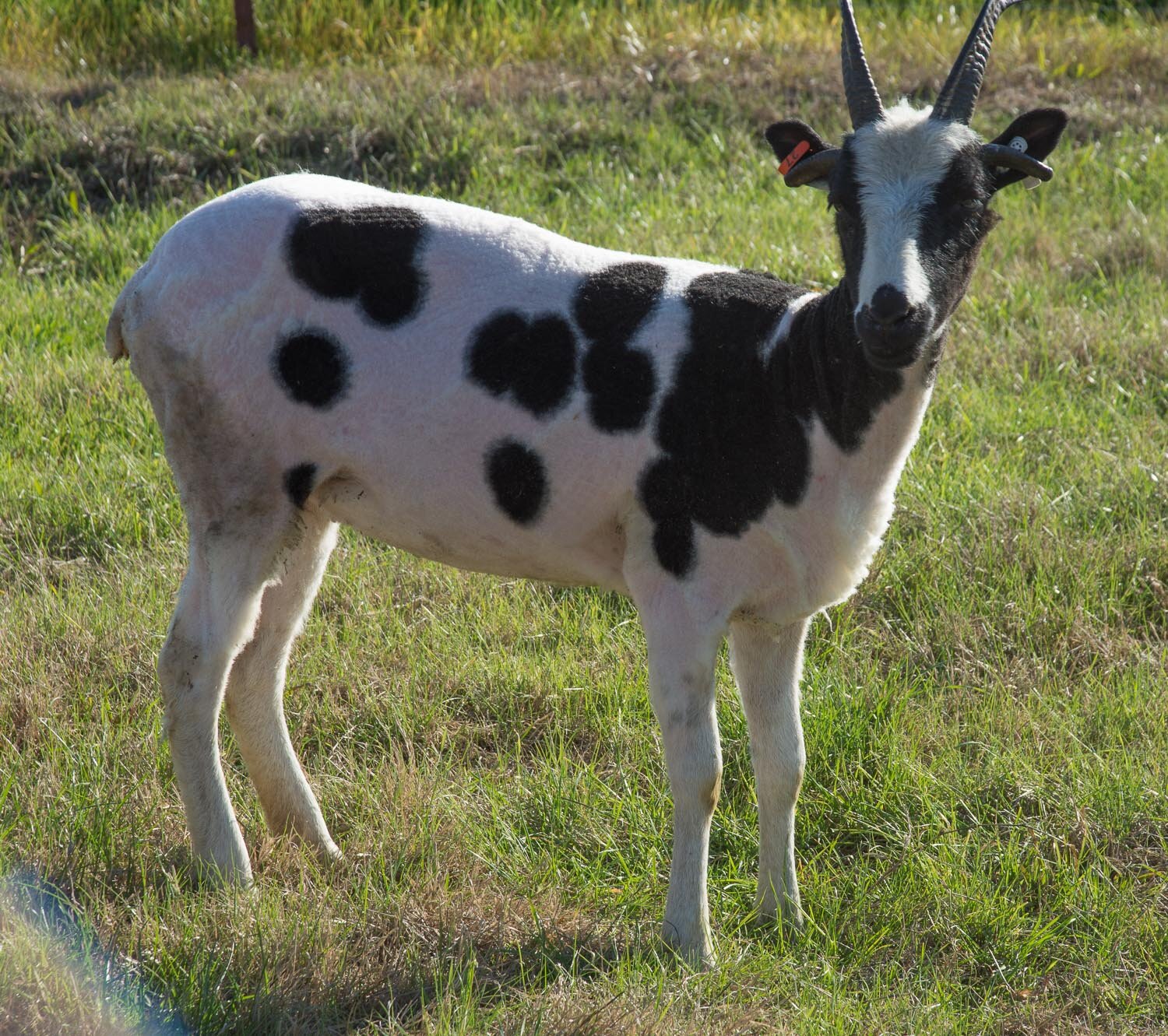
Here she is after her first shearing.

This is what her fleece looked like before shearing. Royal bought Saffron in 2018 with the plan that she and two other yearlings could make it to Maryland Sheep & Wool Festival in May by catching a ride with the sheep of another friend who shows back there every year.

Saffron’s sire is bide a wee Buster of the Bide a Wee farm in Oregon. This is a photo from his first season of breeding here.

Buster is on the left with Clark, one of his sons, on the right. I find it interesting to compare the lamb and adult photos. Buster has sired a lot of sheep, some of whom are still here.

The combination of Sonata (the ewe in this photo) and Buster produced another nice lamb, Soprano, in 2018.

This is Soprano as a yearling at Black Sheep Gathering in 2019.

Royal did very well at the show where he showed the Champion Jacob ewe. He also showed the Champion Jacob ram, the Reserve Champions, and Best Flock. This is Patchwork Cooper. Patchwork Farm is where two of my new lambs came from and I think Cooper is somehow related but now I don’t remember how. I sure love those horns.
I think that I should add here, that it’s not all about the showing. All of us have plenty of nice sheep that have never won awards and we all point out that it is just one person’s opinion on one day so it’s not really that important. But, hey, the shows are fun and why not brag when you have the chance? I hope that we’ll be able to do a little bragging next year, but the first step will be that the shows won’t be cancelled. The biggest news I heard about the California State Fair for 2022 is that they have a new category to enter—Cannabis. Is that enough to make sure the fair goes ahead as planned?
I introduced the girls yesterday. These are the boys who are staying.

Meridian Silverado (Ruby Peak Tamarisk x Meridian Spice) has promising horns and nice fleece. I hope the horns continue to grow as wide as they look in this photo.

This view shows that the horns could be aiming for the neck, but in person it looks as though there is a slight curve at the tips so I hope they grow pointing away.

Meridian Dylan (Ruby Peak Tamarisk x Meridian Lavendar) is very similar to Silverado and I will keep watching his horns as well.

Meridian Atlas (Meridian Axle x Meridian Vixen) is a lilac ram, twin to Lupine who was in yesterday’s post.

Meridian Orion (Ruby Peak Tamarisk x Meridian Skye) is the last ram I have here for sale as a breeding ram. He has a great horn spread and nice looking fleece. He is listed on the ram lamb page.
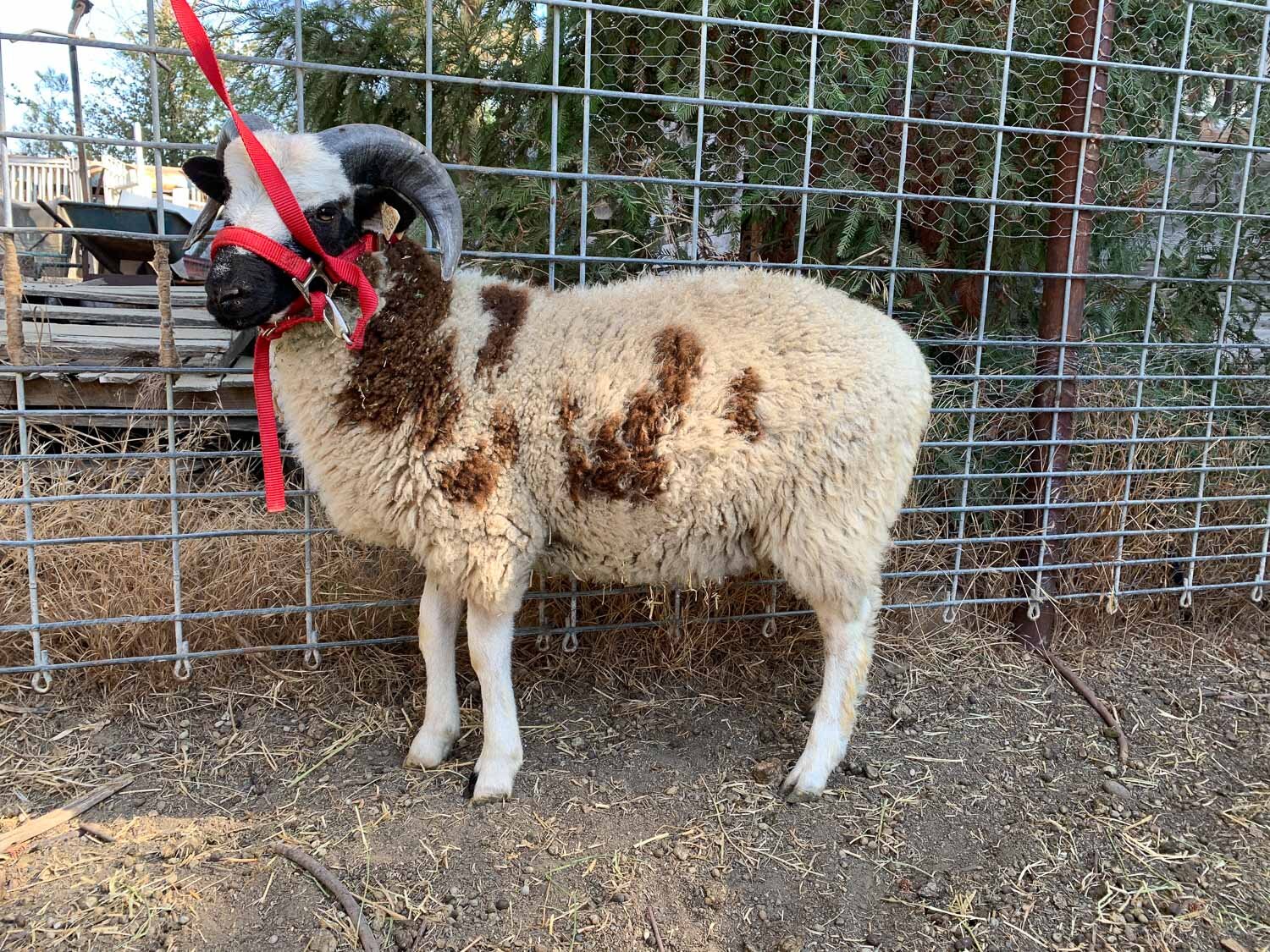
Hillside Barrett came from Michigan last month along with the ewes in yesterday’s post. He is about a month younger than the other ram lambs, but hopefully he’ll be able to handle a few ewes in October.
I just spent the last few hours submitting registration applications for this year’s lambs. So I have current photos and thought I’d make introductions of these and new sheep that I got last month.

Meridian Betsy (Ruby Peak Tamarisk x Meridian Betty) is a ewe lamb that is still on the sale page. I wouldn’t mind keeping her but I probably have too many sheep and I’ll have more next spring.

Meridian Columbine is a ewe lamb out of Cashew, who lambed this spring as a lamb herself.

Meridian Juniper is one of the few lambs sired by the the ram lamb (now yearling), Rambler. Her dam is Jasmine.

Meridian Lupine (Meridian Axle x Meridian Vixen) is the only lilac ewe lamb I kept. She also has almost the most color of all the lambs staying. It seems I ended up with a lot of light lambs.

Meridian Quinci (Ruby Peak Tamarisk x Meridian Quartz) is on the sale page and may be spoken for but if she doesn’t sell I’ll be happy to keep her.

Her sister, Quail, is one that I had my eye on not long after they were born. I thought she looked very flashy. Now that they have grown up I like Quinci’s horns much better than her sister’s. This photo was taken several months ago. I need to get a current photo.

This is another photo from a few months ago. This is Beauty (Meridian Jasper x Meridian Belle), owned and named by my granddaughter.

Isn’t this a cute lamb? She is Patchwork Amara, a lilac lamb from Georgia and is a real sweetheart. I have a t-shirt that reads “You can’t buy happiness, but you can buy a sheep and that’s almost the same thing”. I am very happy because I bought six new sheep that arrived last month. A friend made all the convoluted transportation arrangements and she and I both got sheep from three breeders in Georgia and Michigan.

This is Amara’s BFF, Patchwork BettyLou. They are both very sweet lambs who come up to the fence for treats if the big scary ewes aren’t in the way.

They are now friends with Hillside Grace, a pretty lamb from Michigan.
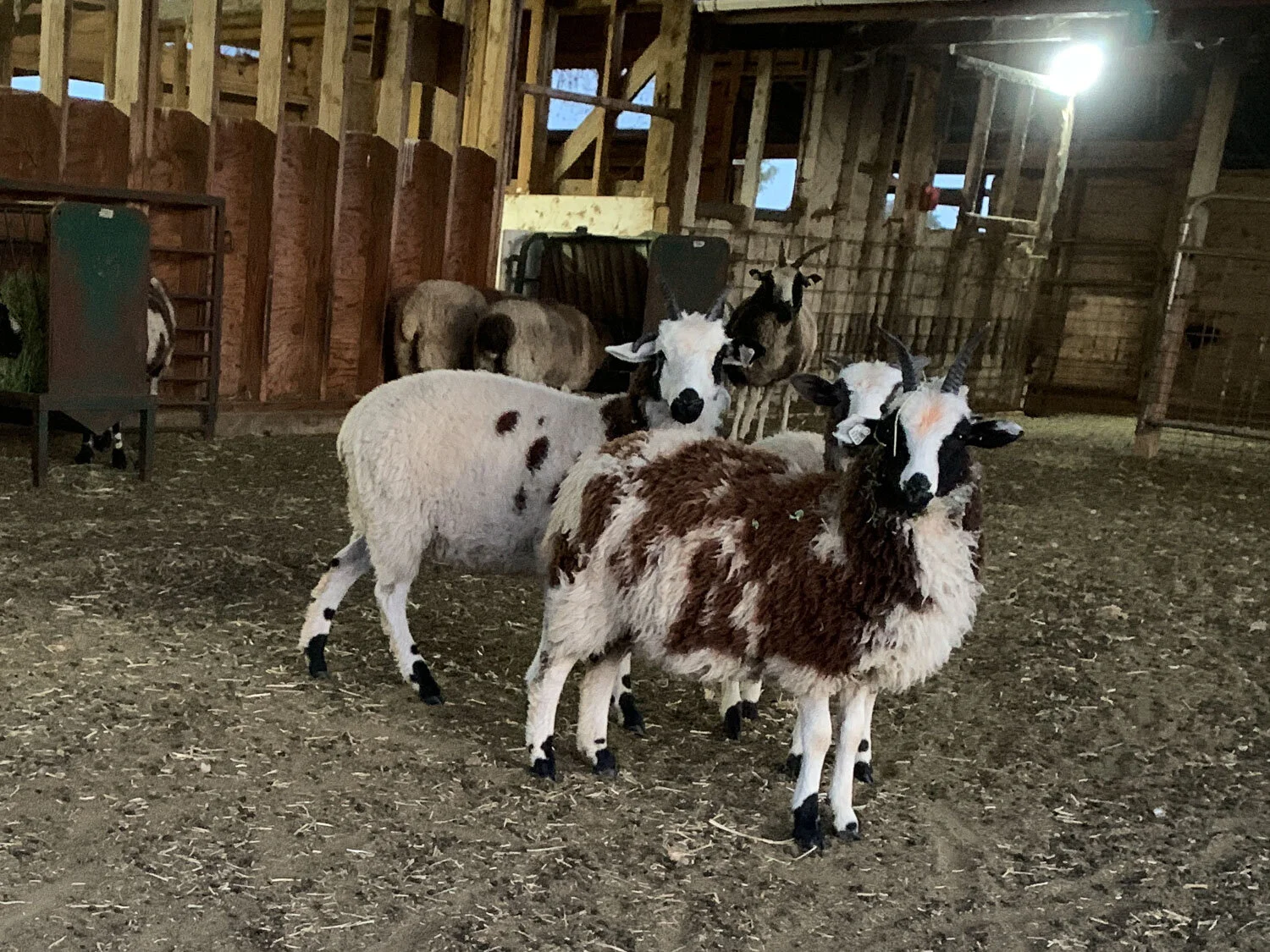
These three all hang out together, often away from the other sheep.

BettyLou and Amara have no qualms about approaching for treats. Grace is much more hesitant but if I’m very still and her friends are right there, she’ll risk it.

Sweetgrass Tranquility and Eilwen are two-year-old ewes who came on the same trip with the lambs. I sure look forward to seeing what their lambs will look like next year.

At first the five new ewes didn’t mingle with the rest of the flock. The two older ewes and the three lambs still associate mostly with each other. I also got a new ram lamb, but I’ll do another post to introduce all the rams.
Our farm is on the edge of California’s Central Valley. This is a Mediterranean climate where we expect hot, dry summers and cool, wet winters. Lately we haven’t had the wet winters that are so important to fill up reservoirs and aquifers to get us through the dry summers.
Here on this farm we don’t face the dire circumstances of those who live in many other areas of the West where forests are dyeing and burning, reservoirs are almost dry, and some people are out of water. We are fortunate that we are in the area served by Solano Irrigation District (SID) and our water comes from Lake Berryessa.

I found this graph from the Solano County Water Agency. I was surprised to see that the lake level was so much higher in July 2020 (left side of graph) than during the winter of 2020-2021. I know that we didn’t get enough rain (about 40% of “average” here) but I didn’t realize that even that amount of rain didn’t increase the water level in the lake.
This blog post has taken a turn other than what I intended but I’m sitting here at my desk at about 8 p.m. It’s still 97 degrees outside and it’s about 90 degrees in the house. I hope that our “delta breeze” kicks in and blows cooler air through the house tonight.

The original plan for this post was to share irrigation photos but I want to make it clear that I know how fortunate we are right here and I am grateful for the water. Notice the dry grass on the left of the photo. That’s what land looks like without irrigation. This is the view at the northwest corner of the property. Lake Berryessa is about 20 miles away in the hills (view covered by a new almond orchard). When we ask for water it comes down that ditch that is off our property and into the standpipe. It flows out at the base of the standpipe and into our ditch.

I should have a photo of the ditch that goes east from the standpipe, but I got distracted by blackberries.

They are so good.

The standpipe and the ditch at the north end of the property are to the right of this photo, at the north end of what we still call the horse pasture, although there haven’t been horses there since Katie left for college and took her horse with her. In this photo the water has already covered the horse pasture and then flows east/west in this ditch that borders the other pasture. At the point when I took these photos we’d had the water flowing for about 33 hours. We usually hope to finish in 24 hours but we have been extending the time between irrigations lately to hopefully extend our allocation into the fall. The ground was so dry that we figured that we would need more time to complete the irrigation at the south end of the field.
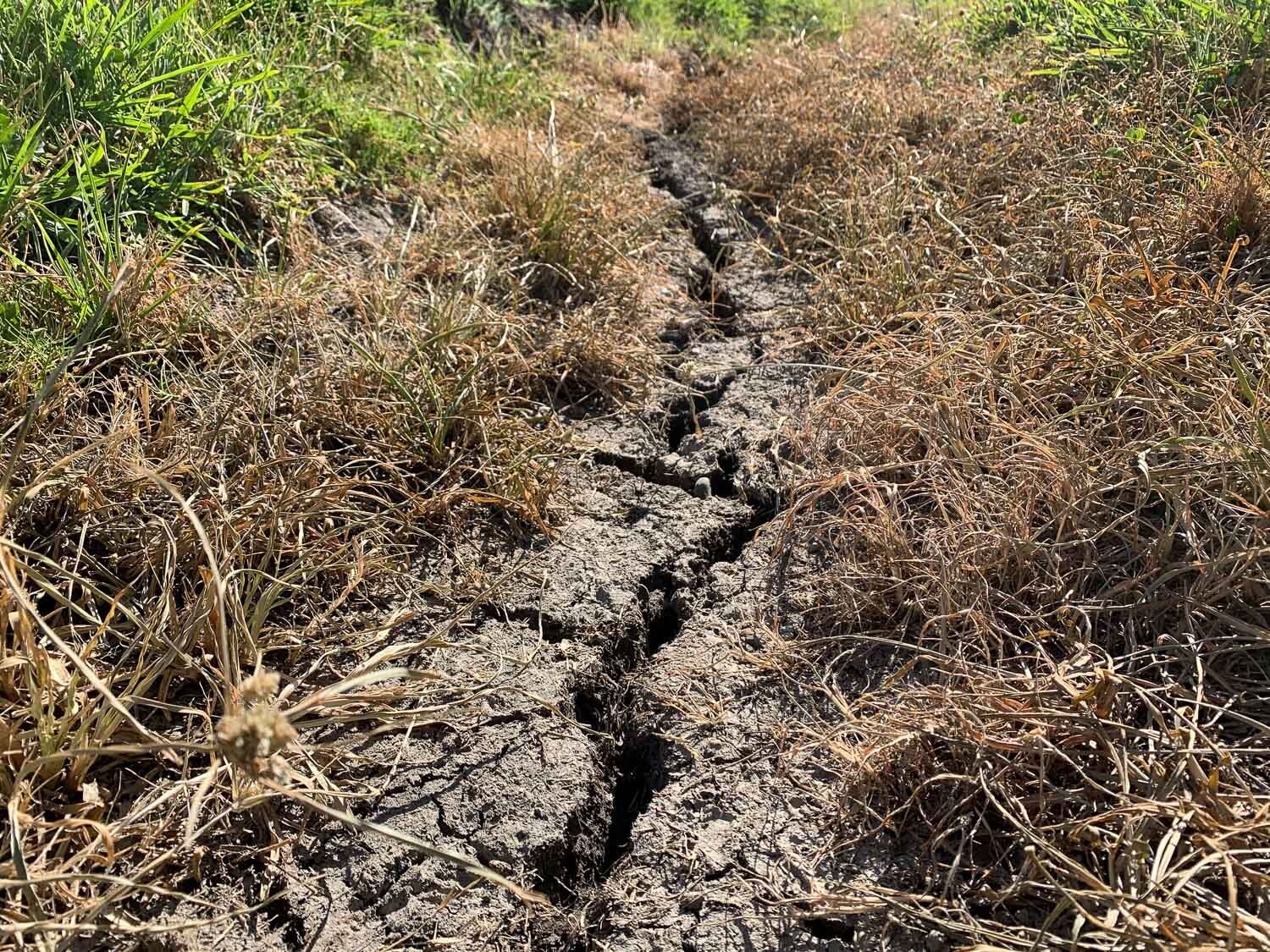
I took this photo at about the same spot as the one with the water a few days ago. The ground was so dry that I could barely get the electric-net fence posts in place.

There are cut-outs in the ditch so that the water will flow out of the ditch through the pasture .

Looking southwest. Those fields are finished.

This is from the south end of the property looking back to the barn. This morning the water wasn’t down this far and we really did need those extra hours to get coverage everywhere.

This is the tailwater ditch at the south edge of the property. The idea is to channel excess water into the main canal off the property. However I figured out a system to “reverse irrigate”. Usually the paddocks on the west finish first. By blocking this ditch at the east end the water backs up and irrigates the south end of the other parts of the pasture.

This is at the southeast corner where the water finally does flow off the pasture and into the main canal.

The sheep are ever hopeful that when they see someone walking around the pasture it means that they will get to go out. Sorry girls, you have to wait for it to dry out some.

Some of them were hanging out in the shade near the ram pen.

Here is the goal. This photo was taken in the horse pasture that I showed first. The sheep haven’t grazed this since early June. The last irrigation was after they came off of it about 4-1/2 weeks ago.
I am trying to decide which ram lambs to keep. OR should I keep any of them? I wish I had enough land to keep several for a year to see how they look when the grow up. In my situation it is not realistic to keep more than a couple. Even that may not make sense when I still have their sires still here as well.
I caught most of the 4-horn ram lambs yesterday so I could take a better look at them and take photos to send to a potential buyer. I thought you, my faithful readers, might be interested.

This one (2126 Ruby Peak Tamarisk x Meridian Terri) is on my cull list because I don’t like his horns He may have nice wool, nice a good balance of color throughout his body, all the correct face markings, etc, but there are so many things to try and get right with this breed, and the horns are a major one. Those horns are tipping forward. They may never be bad enough to cause him harm, but they are certainly not attractive.


This one (2130 Ruby Peak Tamarisk x Meridian Jingle) certainly has better positioned horns and he has nice fleece.

This ram is 2137, Meridian Rambler x Meridian Patsy. I like his sire’s wool and I think it was passed down to this ram. In this view it almost looks as though his horns are slightly forward but the tips are going back and I hope the horns continue that way. I’m tempted to keep this one to see how he grows. His sire, Rambler, is one of two rams I have sired by Jasper who was sold this spring. Rambler had just enough color to be registered and this guy is also on the light side. He also has a pink nose which is not as desirable. But take a look at that wool.



Lamb 2148 (Ruby Peak Tamarisk x Meridian Janna) is a decent looking ram with good markings and nice wool, but what about his horns?

Broken horns will grow back but I don’t know for sure how they will look. Will that lower right horn curl out of the way of the jaw or grow right into it?

I had high hopes for 2151 (Ruby Peak Tamarisk x Meridian Honey) because Honey has such great wool. Strike 1 - lower horns growing in towards the jaw on both side.

Strike 2 - freckling. This makes for a pretty fleece, but a Jacob sheep is supposed to have large spots. Freckles are different and they increase in number as the sheep gets older. Its one thing to have a freckled ewe, but a ram will pass that trait on to many offspring and change the look of the whole flock. Notice that the freckled fiber doesn’t show up at the tips of the fleece. You can’t see freckles when a lamb is born. I think it’s in the secondary follicles that mature only after the lamb is born, so freckles may surprise you when you look at a lamb that is a couple of months old and only starting to show the trait.

Ram 2156 (Ruby Peak Tamarisk x Meridian Lavendar) Where are those lower horns headed?

This guy’s wool is OK and well within the breed standard, but it doesn’t have the visual appeal of those others. This one was also a bit shorter. On the plus side for this ram, his dam is lilac (the brownish-gray color pattern in Jacob sheep) so if bred to a lilac ewe would be expected to produce lilac lambs 50% of the time.
I just looked back at a blog post I wrote 2 weeks ago. Many of these rams are in photos there too. You can check out the changes.
Farm Club members are coming next Saturday. We’ll probably catch these all again and evaluate them further. We’ll catch the two horn rams also and make some decisions about them.

We irrigated last week and for a time had our own private wetlands complete with a small flock of Canada geese. Now the pasture is dry but I have heard a lot of honking the last few days. I think this goose was calling his mate.

He eventually flew off…

…but not far. Just into the pasture.

Together.

A Jacob breeder who lives about 2 hours from here wanted to buy the ram, Jasper, and I offered to deliver him. The wether (who happens to be one of the few sheep I am trying to keep coated to keep his fleece free of VM) went along for the ride. It seemed as though it would be less stressful for Jasper to not be completely alone in the trailer. Also we were delivering a ram for Jasper’s buyer to a location that was on our way home.

The horns on this wether are the main reason that he was castrated as a lamb. Most of the rams that don’t meet certain standards will go to the butcher market but this one lucked out and his job is to be a companion to any sheep that needs a buddy.
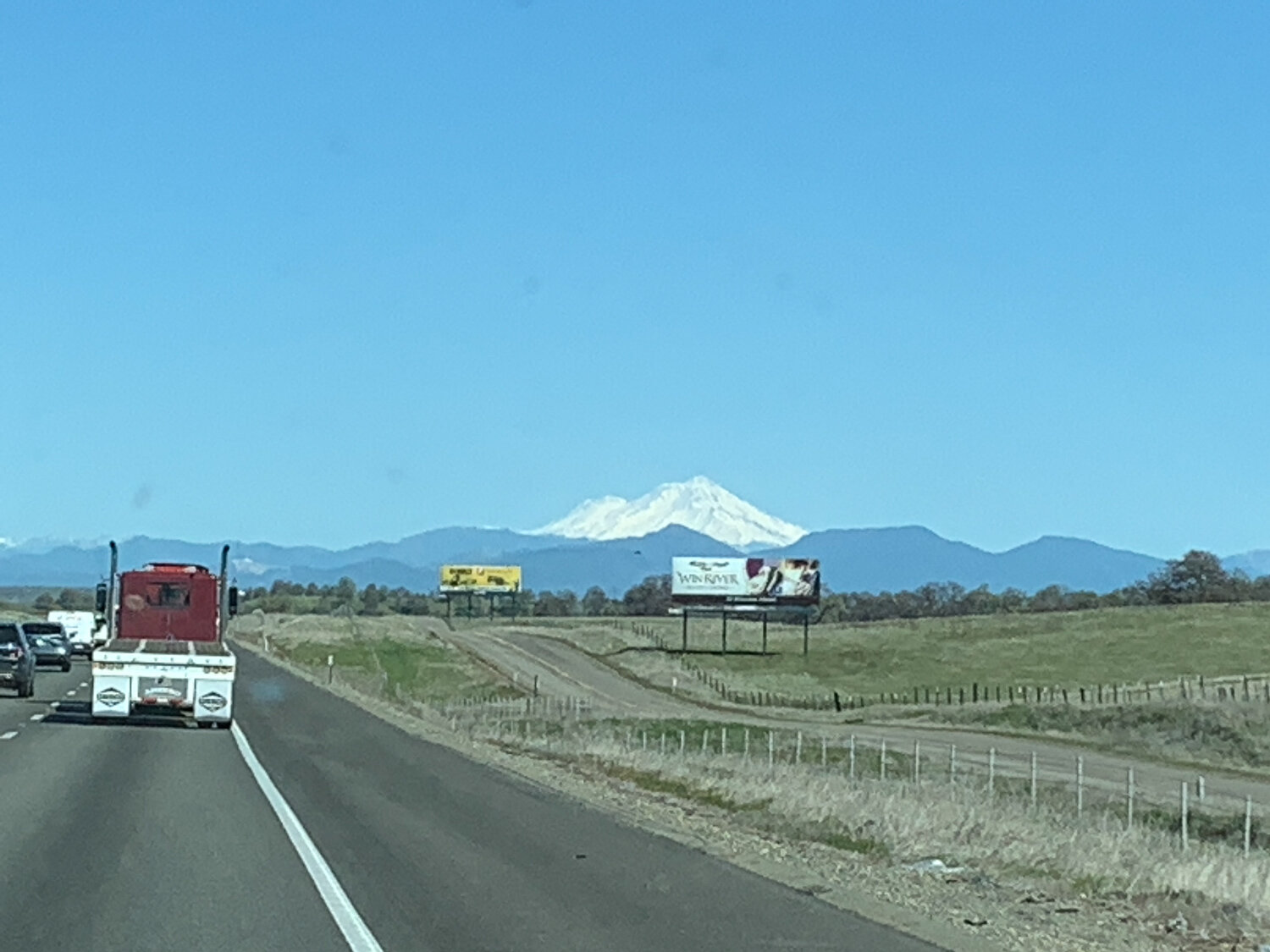
We drove north and eventually had a clear view of Mt. Shasta. The north wind was incredibly strong that day—so strong that our truck struggled heading due north and pulling the trailer. Time for a new truck?

Jasper ended up in a nice place—a large field and a bunch of ewes. What more would a ram want?
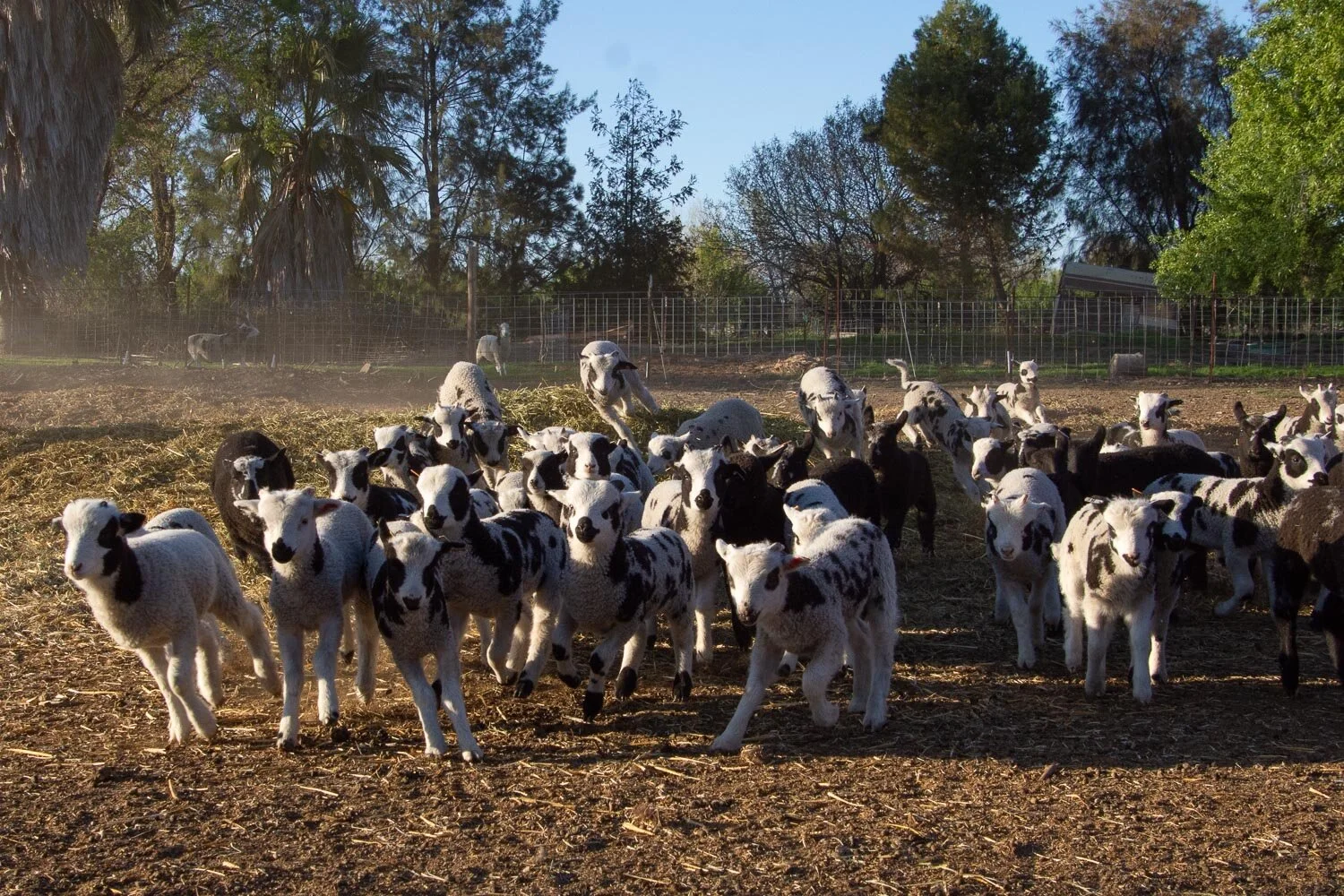
Back home, this is my entertainment every evening.

People have asked why the lambs run and i don’t know. They just do. It’s a Lamb Flashmob. If I’m still in the barn I hear them thundering past.

They run for 15 minutes or so and then they give it up and go find mom or get some hay.


We delivered Jasper on Friday and Axle went to a new home the day before. That left Tamarisk by himself so we put a wether in with him. Today we moved the yearlings, Rambler and Jangle, into the grown up ram pen where there will now be three. We started with a small pen and included a bale of straw as an impediment. There isn’t much space but the idea is that they will figure out who is boss without the major damage that could happen if they were able to back up and charge each other. The wether is still in the ram pen but not forced to be in with the others while they battle it out. Hopefully after a few days they will be BFFs. I assume that Tamarisk, the older ram, will be the boss of the other two.
I am a few days late on this post because the last lambs were born on Friday and it is now Monday.

This is Meridian Roca, a yearling (born 3/4/2020) with the last lamb of the season. She delivered easily the evening of 3/26 and was a great mother from the start.

Meridian Foxy is a 6 year old lilac (coloring of gray/brown instead of black) ewe with a small (5.4 pounds) ewe lamb born early that morning. I had given up on Foxy and decided that she wasn’t pregnant even though an ultrasound showed that she was. I thought that maybe she had aborted. I had been keeping the last three pregnant ewes in a separate area but had just turned Foxy out with the rest of the ewes the night before. She surprised me with this lamb the next morning.

This is Cashew, another yearling, with her ewe lamb born on 3/23.

I may want to keep this little ewe lamb. However there are plenty of others I’d like to keep too. Decisions…

I like to keep track of lambing stats. If you look at my lambing board you will see that lambing began 2/20 with twins, six days before the first “official” due date. There was a breather of a few days and then they started coming on 2/24. There were 84 lambs born in 19 days with a high of 12 lambs born on March 1. Lamb # 86 was born 3-14 and then a gap of nine days before the last three. The lambs are color coded for ram/ewe (not very creative here, but I need something easy to remember). The birth weights are as accurate as I can be, but if I find the lamb already up and nursing who’s to say how many ounces of milk it has already had?
I “process” lambs usually the next day or maybe two after birth. They get a BOSE injection (selenium and vitamin E), a tail band, ear tags, and maybe a band for wethering. With the Jacob ram lambs it’s impossible to know at birth if they will grow up with symmetrical balanced horns (if 4 horns) or wide spread (if 2 horns). So I don’t want to castrate most of them because I’m always waiting for that perfect ram to be born but I won’t know until it’s grown for several months. However, I can tell if they are too light or dark in color to be an acceptable registered ram. The Breed Standard allows for 15%-85% color. If a ram lamb is outside that limit then I will band him to castrate. Those wethers may be sold as fiber pets or as ram companions, or for butcher. There will be another blog post coming up about the color analysis part.
We use two ear tags for each lamb. The first ear tag is preprinted with the ID # which includes the birth year. This years lamb #’s begin with 21. Ewes have that ear tag in the left ear and rams in the right ear. The second tag is color coded by sire and I have written in the ID number. This year I used up a variety of leftover tags but next year I need to start by buying new ones. The gray tags I used are too close in value to the white to easily differentiate. In the lower right corner of the Lamb Board I have my reminder of the colors.

Tamarisk lambs have orange ear tags.

Jasper’s are gray.

There are only a handful of Axle and Rambler lambs and those are red and yellow.

Anywhere you see a X P on the lamb board that means that Peyton, a Bluefaced Leicester, is the sire. The BFL-cross lambs are black so they don’t need a special ear tag to tell me who they are. The colored tags are useful not only for identifying sires, but as a back-up if the original ID tag is lost. It is also helpful to know which color to look for when I am trying to find a particular lamb—the colors narrow the search down a bit.

Ears is a BFL cross herself . She was bred to Peyton so her triplets are 3/4 BFL. The other adult crossbred ewe in the flock is Addy but Peyton is her sire and she was bred to a Jacob ram.

This sometimes seems like an overwhelming number of lambs but so far they are all doing well.

The ewes are hard at work raising all these lambs.
To finish out the stats:
89 Live lambs born, 1 long-dead twin delivered along with a live lamb. One tiny (3.4 lb) lamb died before 24 hrs..
44 rams and 45 ewes
2 triplet births = 6 lambs
36 twin births = 71 lambs (plus the dead fetus)
12 single births (including 3 yearlings)
Average weight of 73 purebred Jacob lambs: 8 lbs (Low = 3.4 and high = 10.6)
Average weight of 16 BFL X Jacob lambs: 9.5 lbs (Low = 7.4 and high = 12.8)
In my system the sheep lamb in the barn (or are taken to the barn shortly after lambing if they were outside. After two or three days in a lambing pen (jug) I move a group of two or three ewes and their lambs to a stall in the horsebarn part of our barn. I think that gives the lambs time to realize that it is important to stick close to their own mom and it gives the ewes time to not worry so much about other lambs bothering them. The ewes can be somewhat aggressive to other lambs and the lambs figure out that it’s better to avoid the other ewes. After a few days they all mellow out and don’t really care anymore.
This time in the stall also gives me a chance to keep a better eye on each ewe and lamb so hopefully I can be aware of any problem that arises. After a few days in the stall they the ewes and lambs go into an area of the barn that is separate from the pregnant ewe area. As more lambs are born, the pregnant side gets smaller and the lamb and mom side gets bigger.
Right now the ewes and lambs have access to the green field that is behind my weaving studio/shop and that gives the lambs a controlled environment in which to learn about the electric fence. The pregnant ewes are on the main pasture. I wrote in one of the last posts how unusually this is because usually when we lamb it is wet and soggy on the pasture and behind the barn there is a lake. That is why I developed this system of where we lamb and how we move the sheep through the first couple of weeks. Wishful thinking that we will get some rain and we can count on that to grow some more grass!

This post has changed focus from whatever I had planned when I started two nights ago to random photos of lambing season. I guess I got distracted and too tired and didn’t get back to it until now. That is Fandango who lambed two days ago. She is one of the oldest ewes here—lambed with twins.

The ewes and lambs that are out of the barn are on the small field behind my shop. This is Jillian and her BFL-X triplets. I never registered Jillian because of lack of color and face markings but she has nice fiber so I kept her. I choose to breed the few ewes that aren’t registered to the BFL ram.
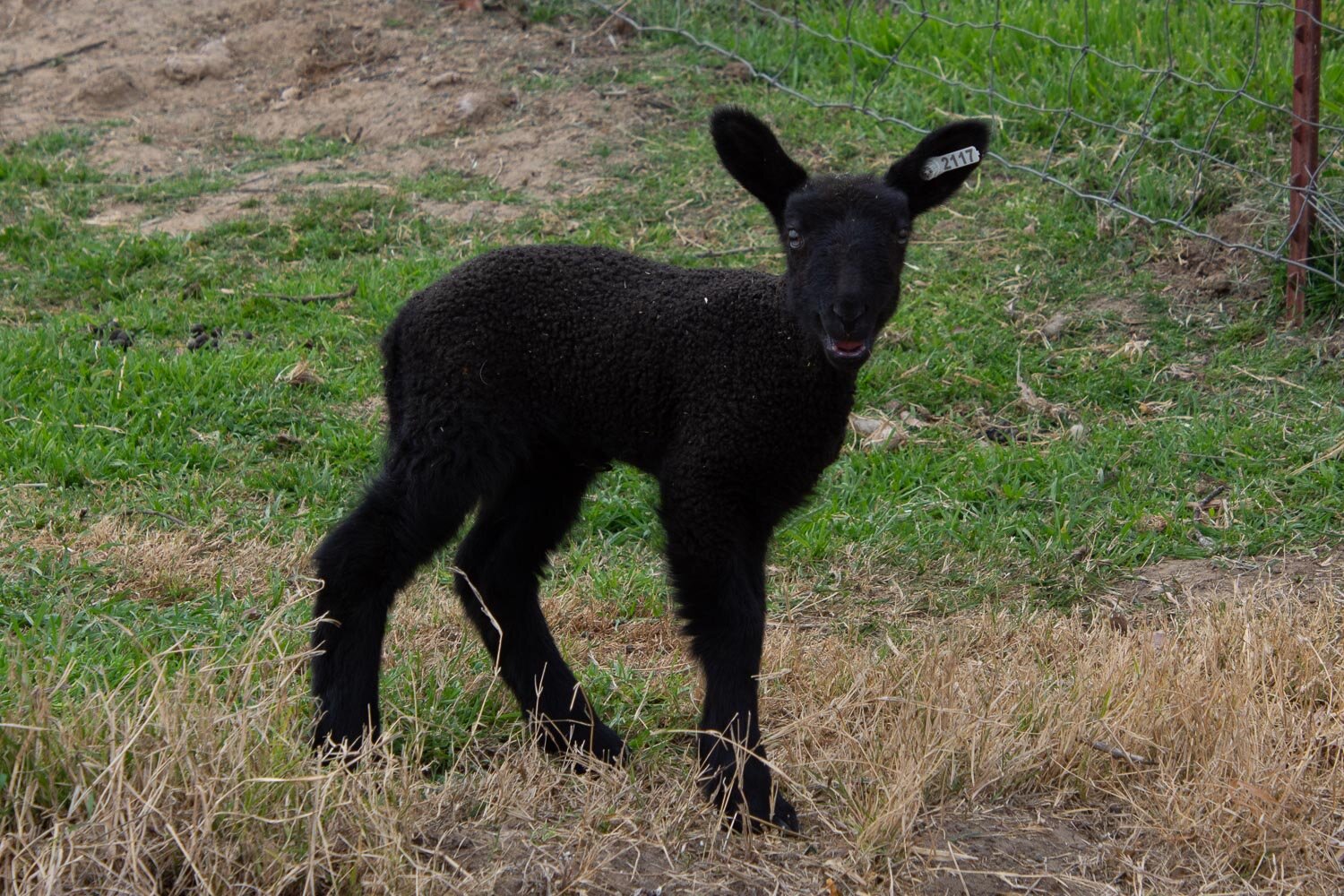
This one is a 3/4 BFL cross. He has the BFL ears.

A yearling ewe named Trina and her lamb.

It’s too late to finish writing much here so I’m going to end tonight with a couple of lamb photos and some daffodils. More tomorrow.


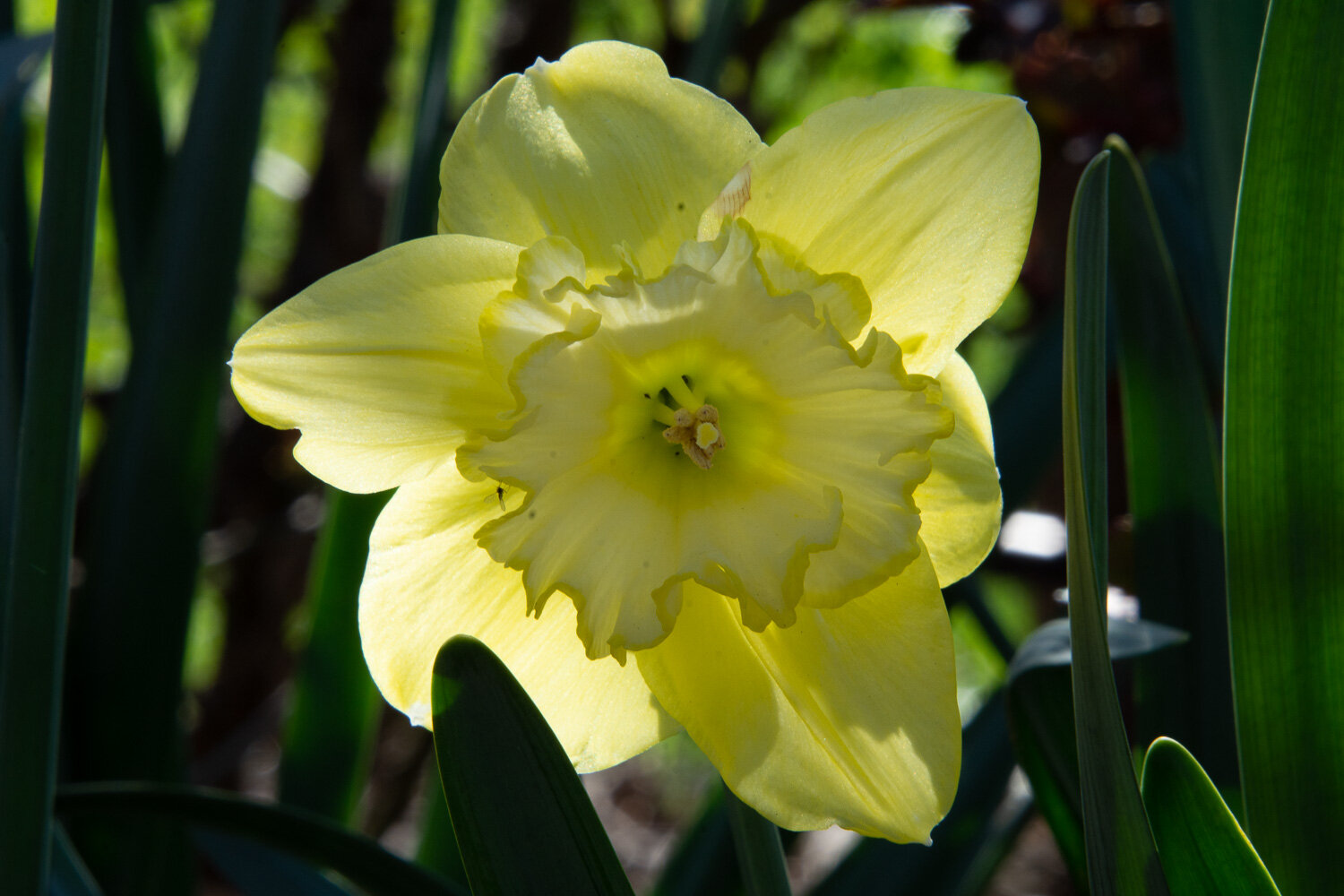
At Meridian Jacobs farm we raise Jacob sheep and sell locally grown wool fiber, yarn, and handwoven goods. We teach fiber classes and sell Ashford, Clemes & Clemes, and Schacht spinning and weaving equipment. We encourage farm visits with field trips and our unique Farm Club.
Search blog posts since 2019. If the search says it can’t find a post try putting in your search word a second time. I don’t know why but the second time it seems to work.
Search the entire website, including older blog posts.